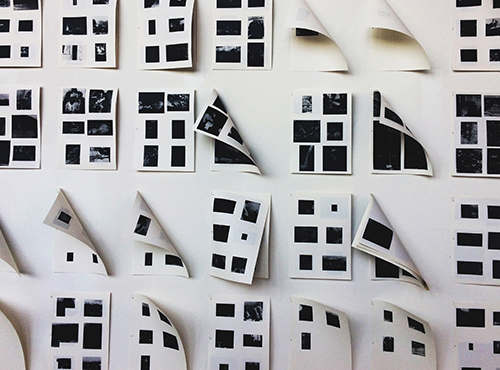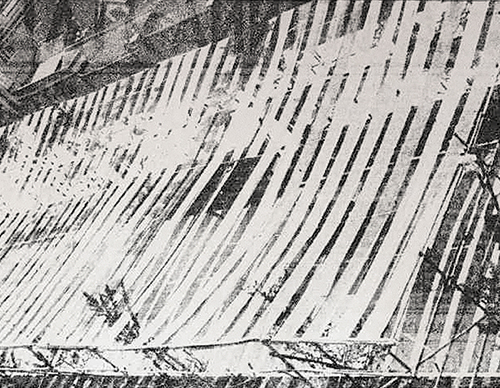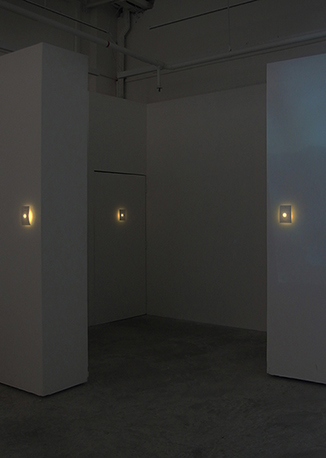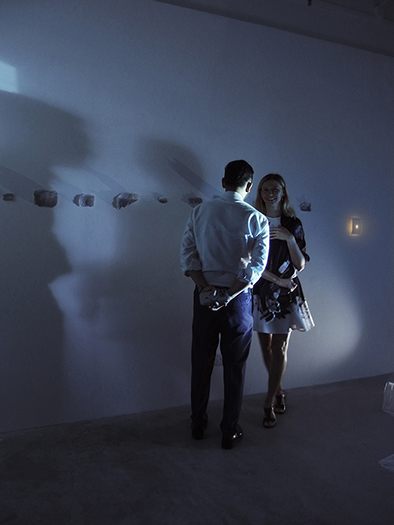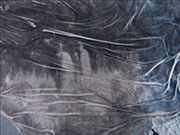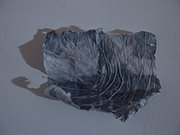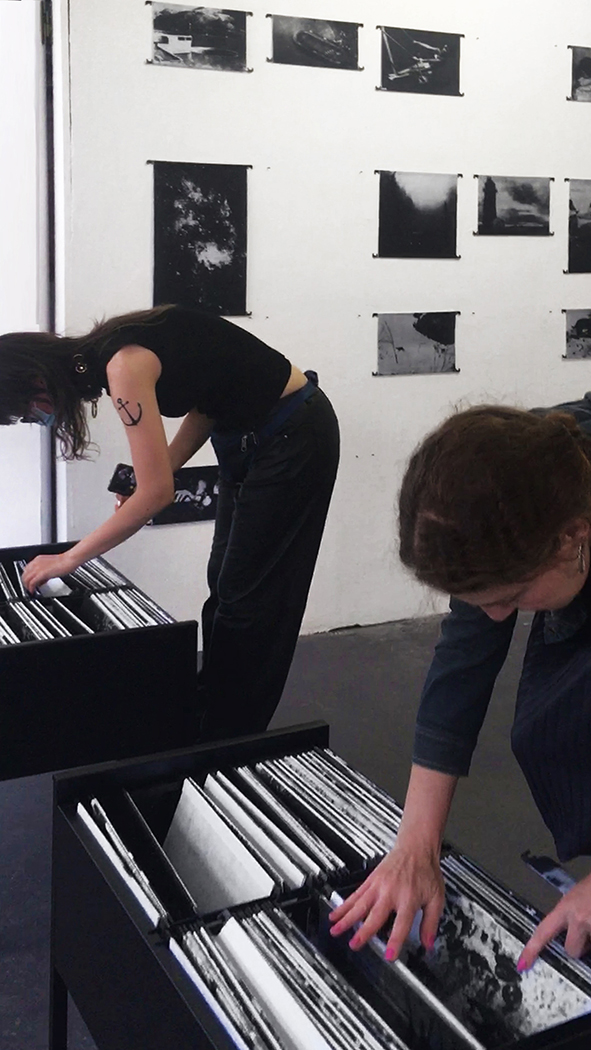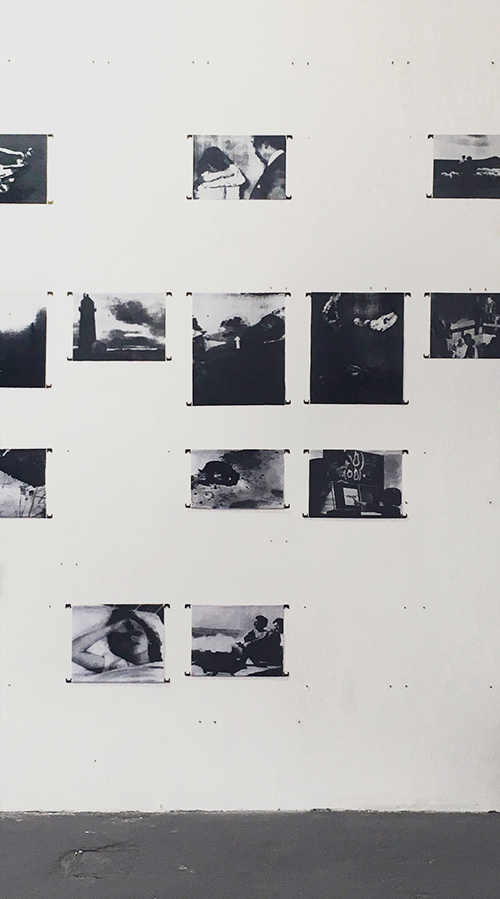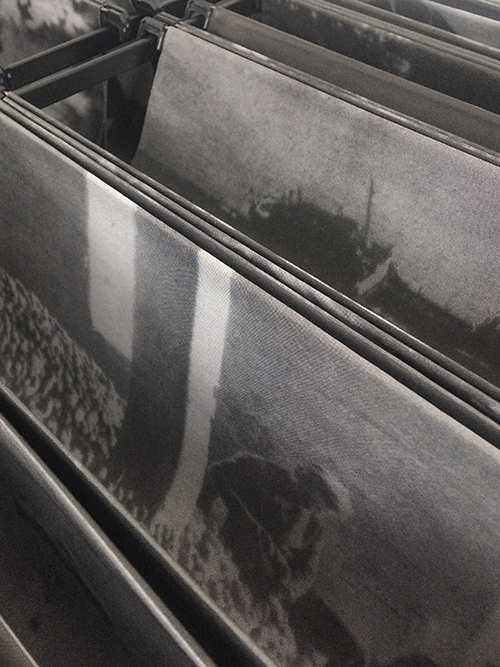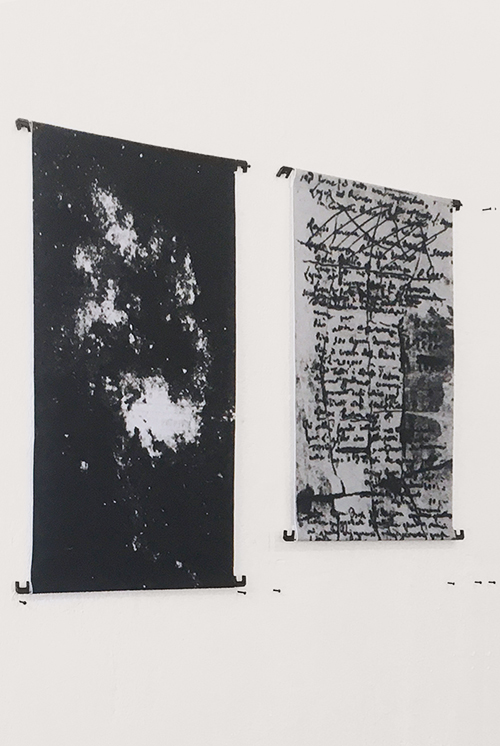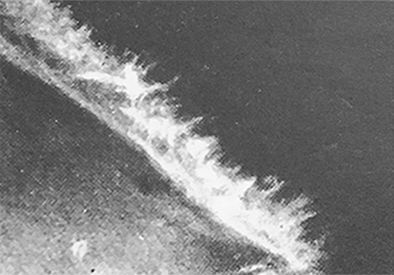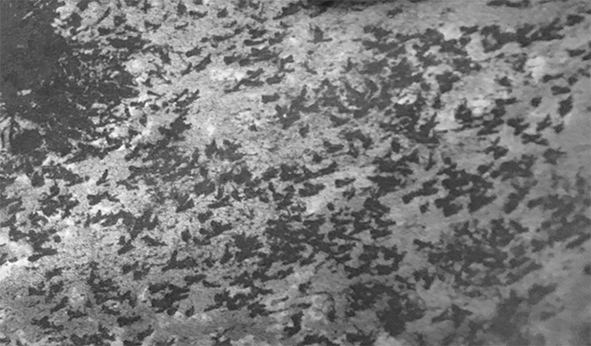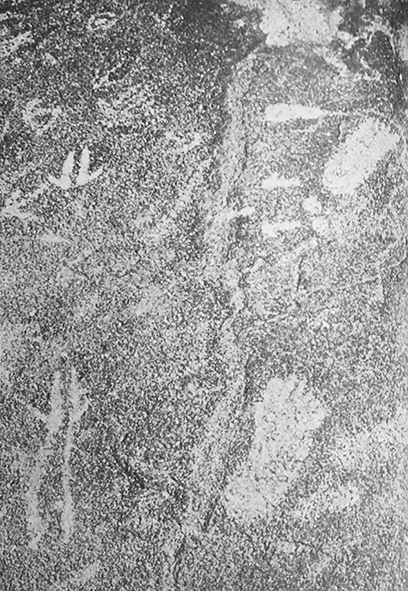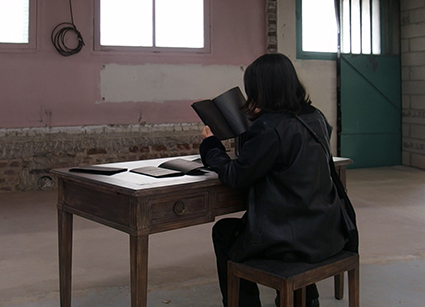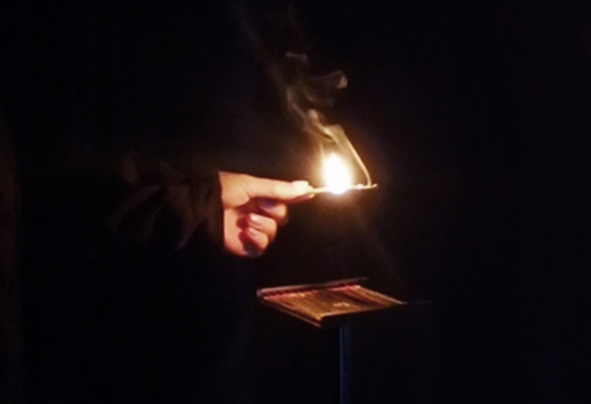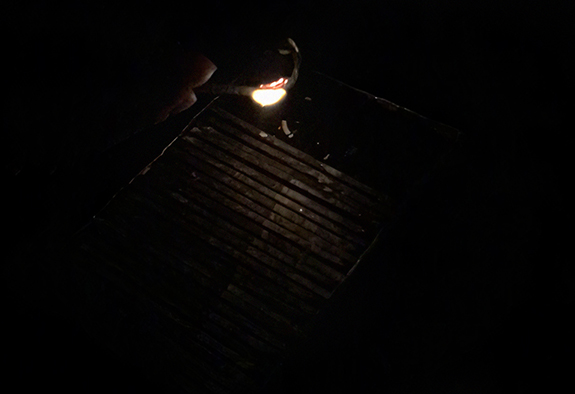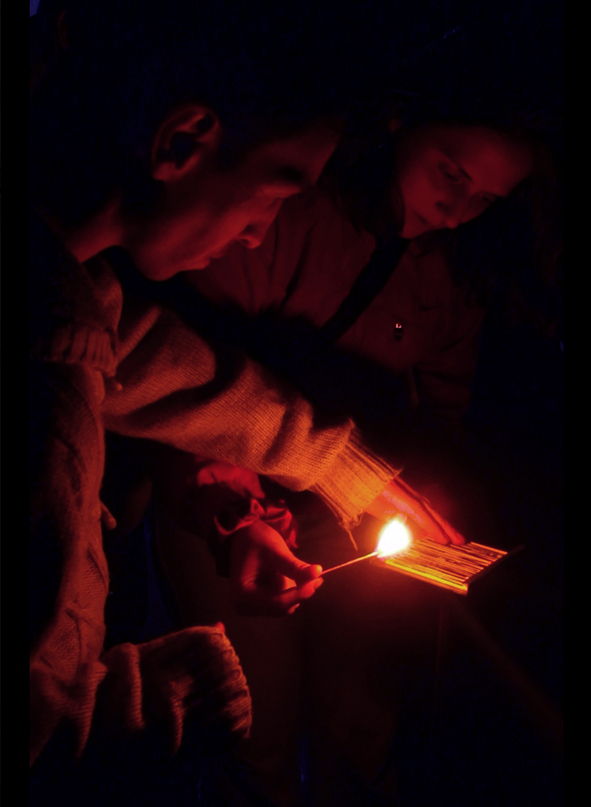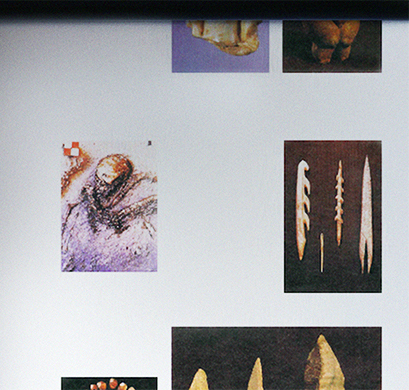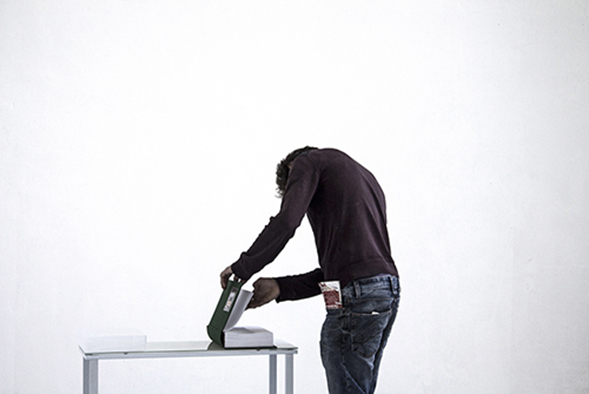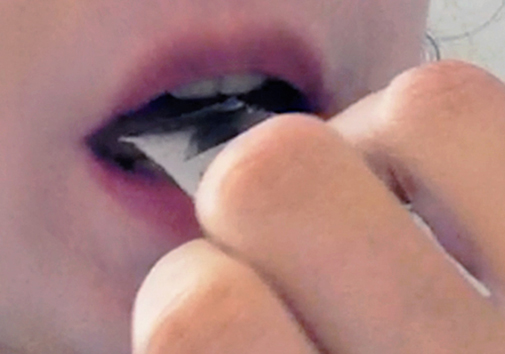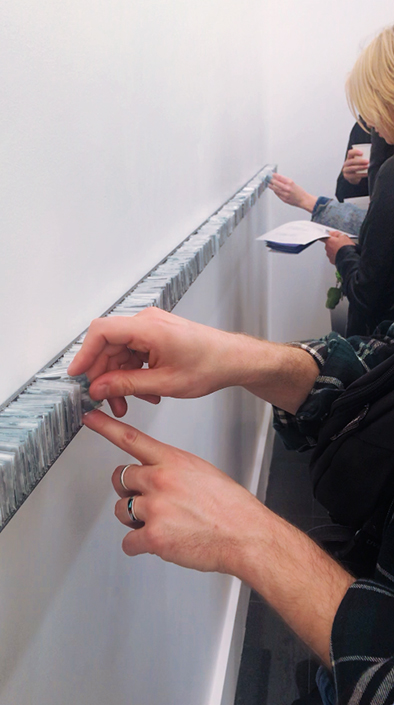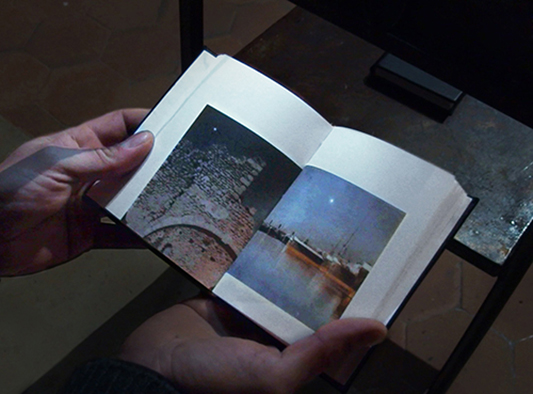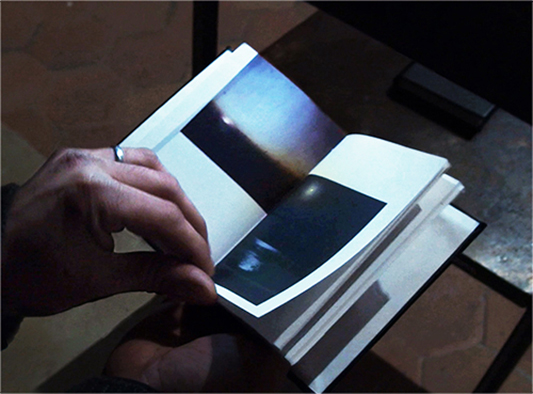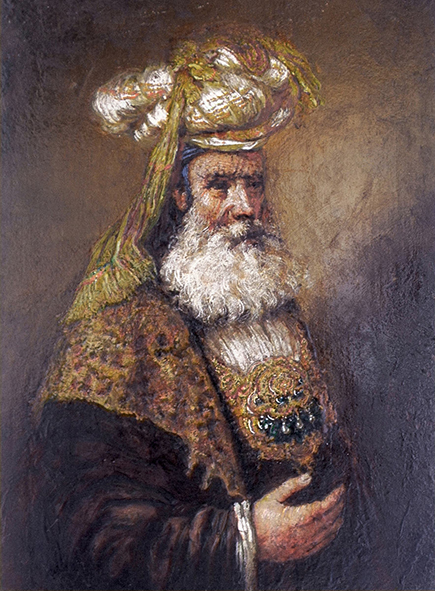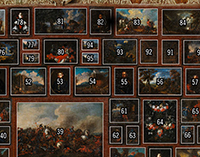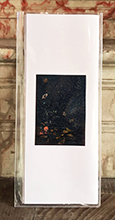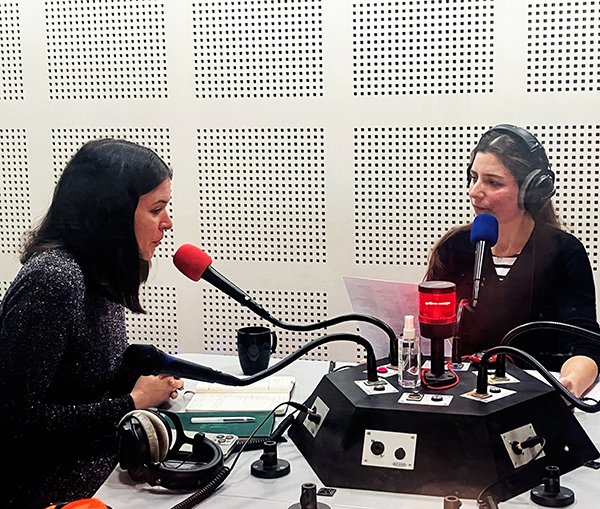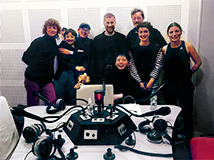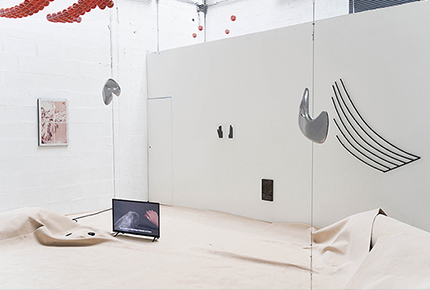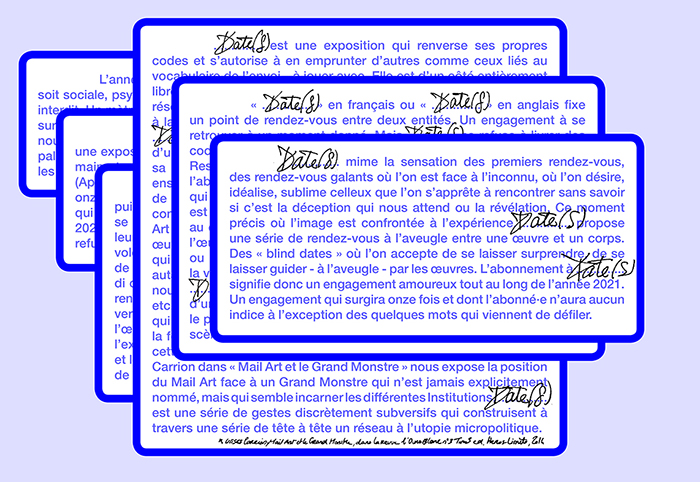Lucie Planty’s artistic practice manifests as collections and assemblages of images that engage with History, examining how it presents itself to us and the potential for the disappearance or degradation of its preservation forms. Her work invites contemplation of memory's various dimensions, the erosion of legend and source, the evolution of digital archives, and the troubling implications of a diminishing capacity for preservation in the face of changes. These collections are curated as interactive image installations that encourage public engagement, allowing viewers to touch, modify, and rearrange them, akin to consultation spaces. Consequently, these installations are inherently modular; their compositions remain open to audience interpretation, continuously transforming alongside their preservation, which depends on the care afforded to the manipulable objects. This exploration of our shared history also interrogates its collective nature: while the content of the work addresses our heritage, its arrangement fosters dialogue and interaction, rendering these installations dynamic and alive. [more ⇲]
LAST CENTURY
installation . 100 booklets . 32 x 45 cm each .
single copies . 2017-2021
with the support of the National School of Fine Arts of Paris and Jeune Création
Last Century is an installation of 100 booklets pinned to the wall, composed of black-and-white images extracted from the pages of the Italian newspaper "La Stampa" between 1900 and 2000. The archives of this newspaper have been digitized and published online, but priority was given to the text, resulting in the degradation of many photographs during scanning; numerous images have become unreadable. These damaged photographs were painstakingly retrieved using a data hoarding technique, with the images reproduced to scale and organized chronologically, one booklet per year. The content of these photographs has become impossible to identify and no longer carries historical information. They now display this paradox: they have been rendered unreadable by the very medium intended to make them visible.
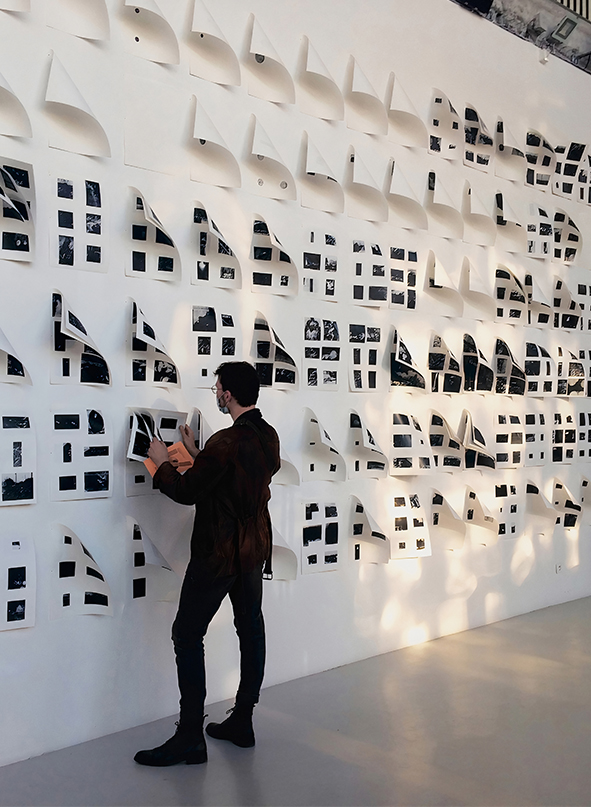
winner of the Folie Numérique Award
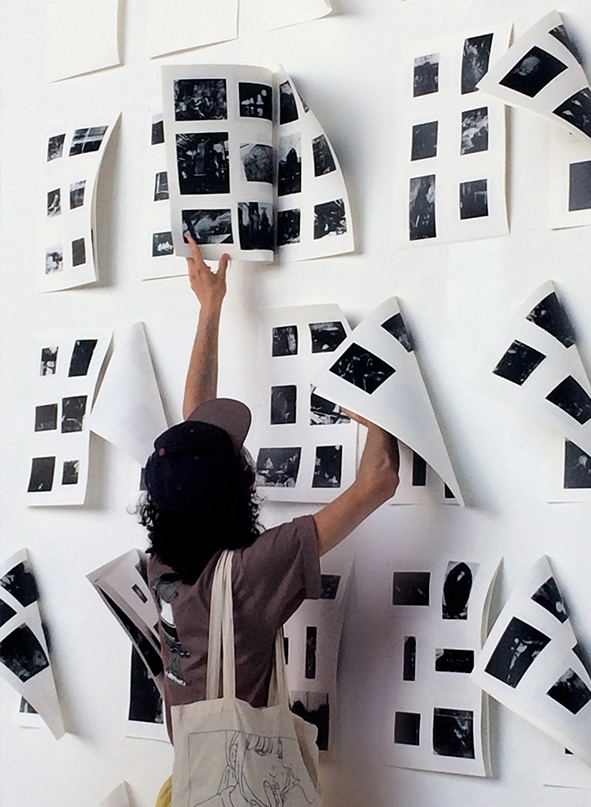
winner of the Folie Numérique Award
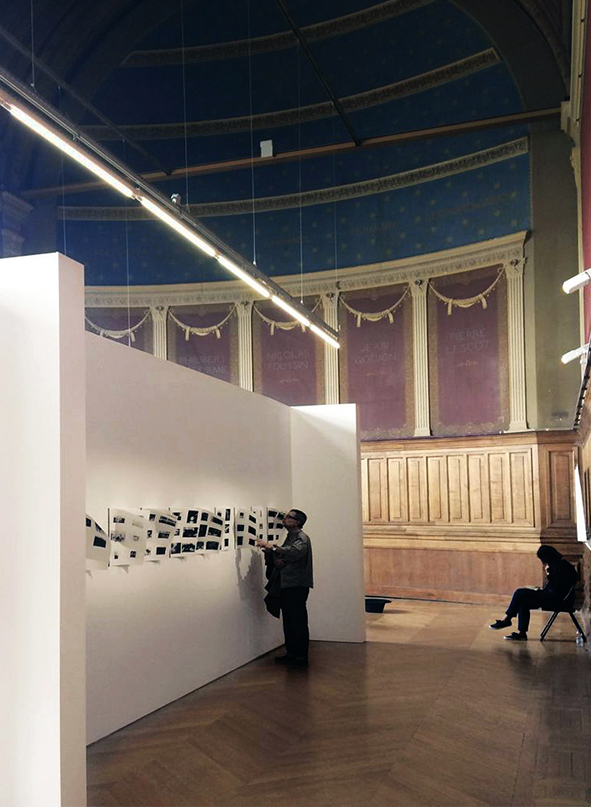
winner of the Albéric-Rocheron Award
SCRYING FRAMES
exhibition & film . 2024
with the support of the French Embassy in Singapore,
the National Arts Council (NAC Singapore), and INSTINC
Scrying frames is both the title of the exhibition held at INSTINC Singapore and a video displayed on that occasion. The film Scrying frames was created from Super 8 film reels. Each of its 20,000 frames was transformed through several stages using traditional digital tools, drawing, and artificial intelligence, and then reconstituted into films once again. It retains all the signs of a reel (shifts, dust, appearances of frame edges, etc.), while possessing a drawn and evanescent materiality. The term ‘scrying’ refers to an ancient divinatory practice of revealing images, particularly from the past, on reflective surfaces—poetically connected to cinema through the various works in the exhibition. These images present such visions: children swimming in a river, lovers resting in a park, and a stroll along the beach—coming to us from an unknown past that we must attempt to decipher, yet, in their banality, they intertwine with our present time..



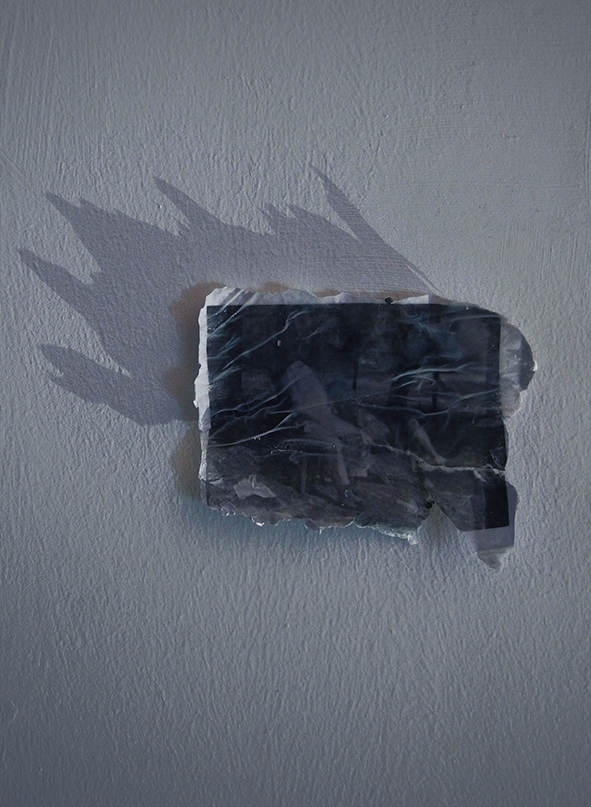
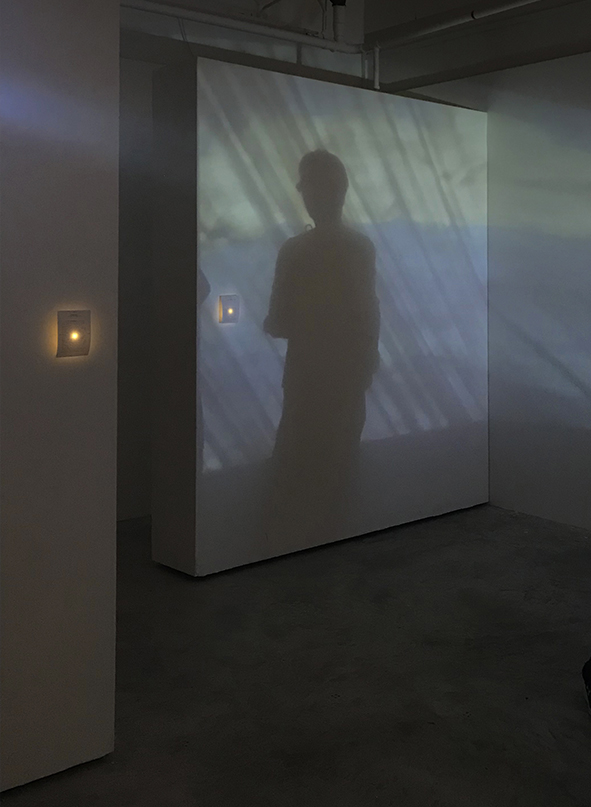
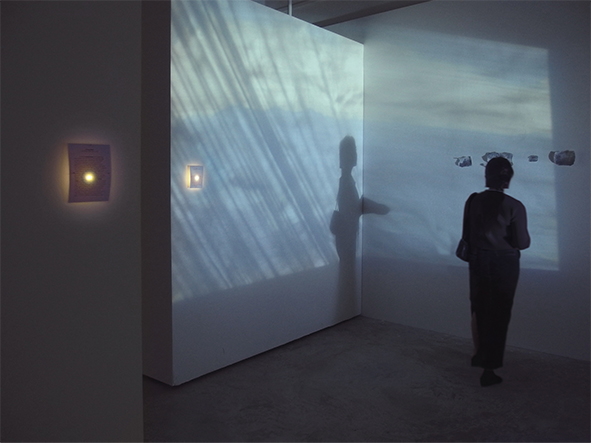
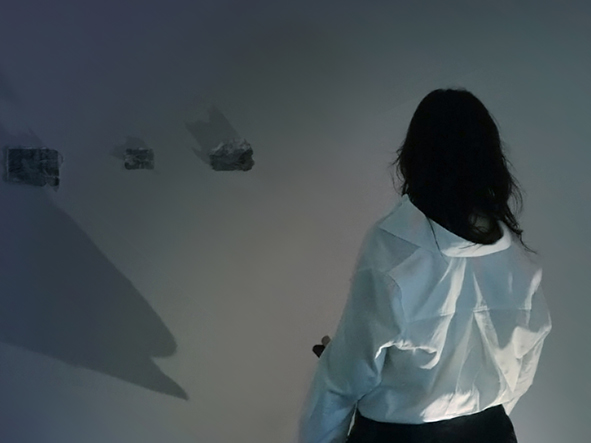

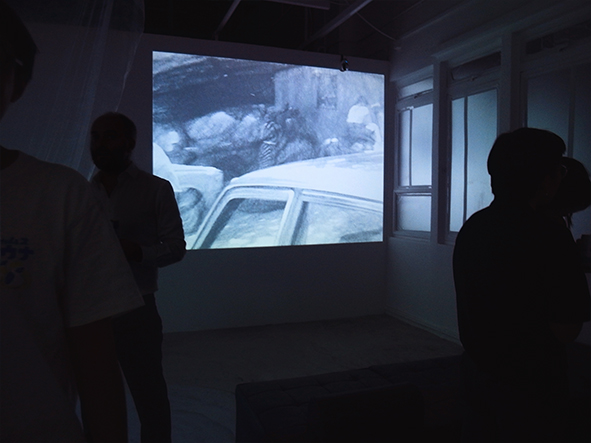
HISTORIES PICTURES
installation . metal furniture 76 x 59 x 42 cm each .
unique images . variable formats . unlimited
amount . print on felt . 2021
Histories pictures is a collection of hundreds of press photographs accumulated over the years from newspapers. These images have been subjectively chosen for their strangeness, composition, and poetry, based on their necessity to convey something about international news within the limited space of a newspaper. This collection is arranged in archive furniture, consisting of prints on felt that can be hung on the wall in variations designed by the visitors. Consultation is left open, allowing individuals to choose the rhythm and layout, creating a narrative combination that renews with each arrangement. Each person projects their imagination and interpretation, telling themselves a story activated by these silent images without captions.

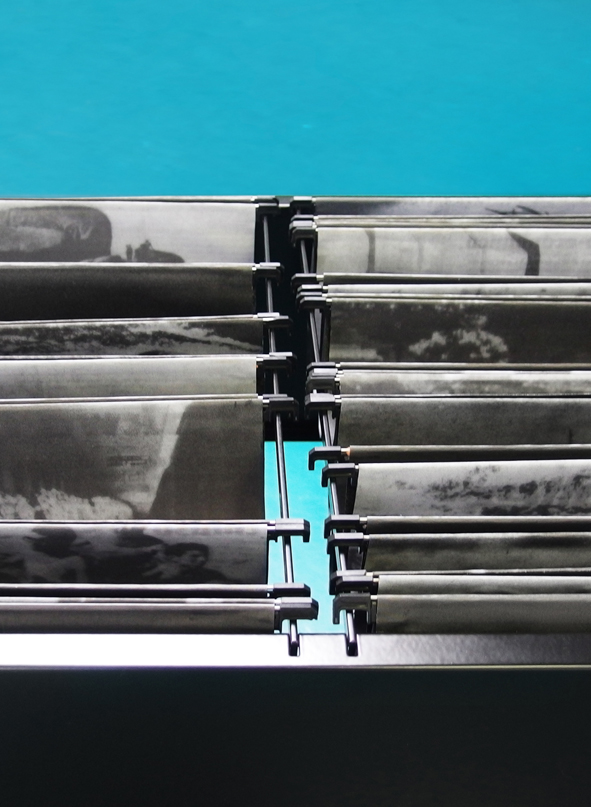
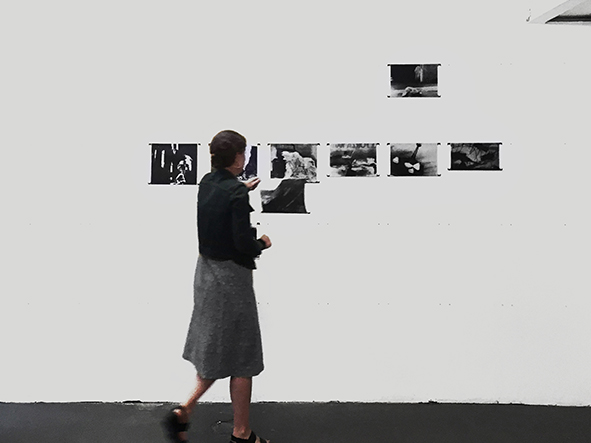

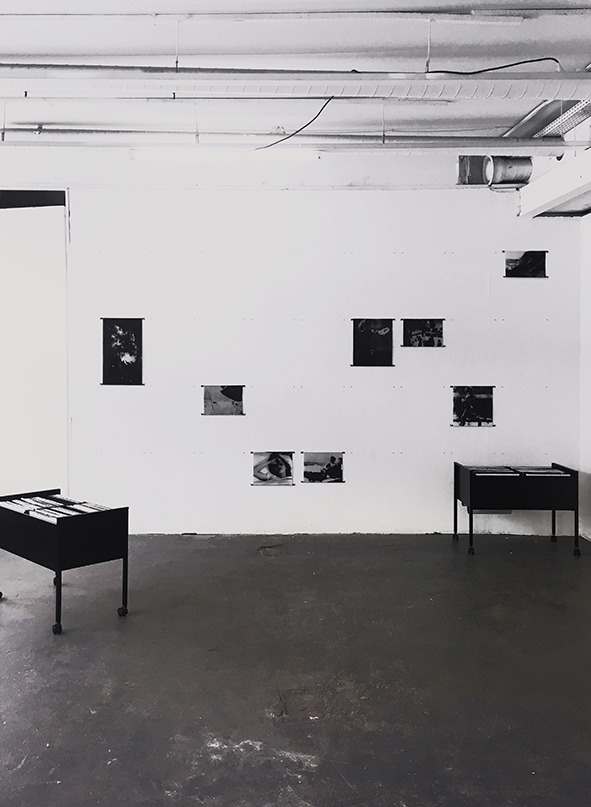
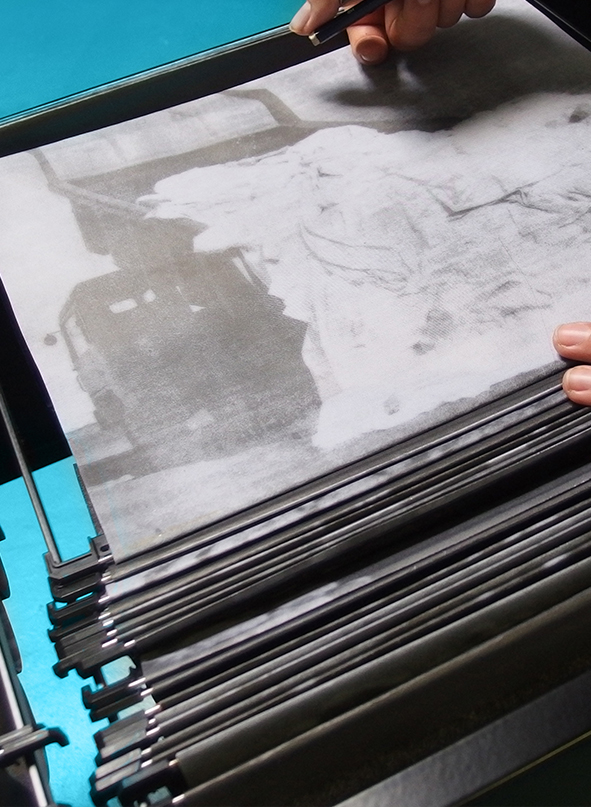
LIBRARY OF SIGNS
(historian's desk)
installation of books . originals from the 1960s
inked . desk and stool .
2023
This installation consists of several dozen booklets arranged in a line on a desk, available for public consultation. The booklets are originals from magazines from the 1960s and 70s dedicated to documenting various types of knowledge. Completely blackened, they appear as if burned or charred, sometimes revealing the printed content in thick ink that was once readable in the light. Only a few images remain uncovered; they appear randomly throughout the pages, and it is up to the visitors to find them. These images present signs. These signs originate from various sources (geological, produced by living beings, human languages, etc.), which, stripped of context and captions, regain their original mystery that precedes their deciphering (unless one possesses that knowledge from memory or it is transmitted orally). These forms, which signify the existence or trace of something, emerge throughout this obscure library, like phenomena in the night of knowledge.
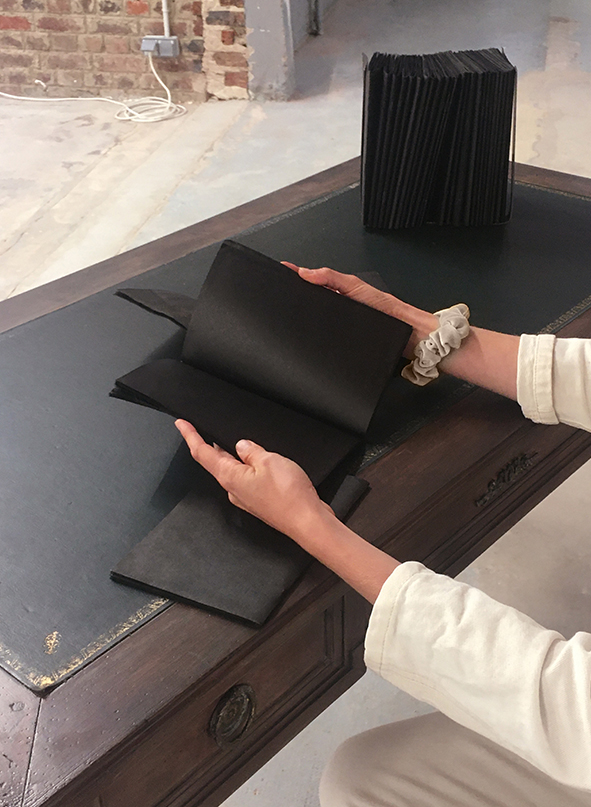
les Jardiniers, cur. Adrien van Melle - Nehama, 2023
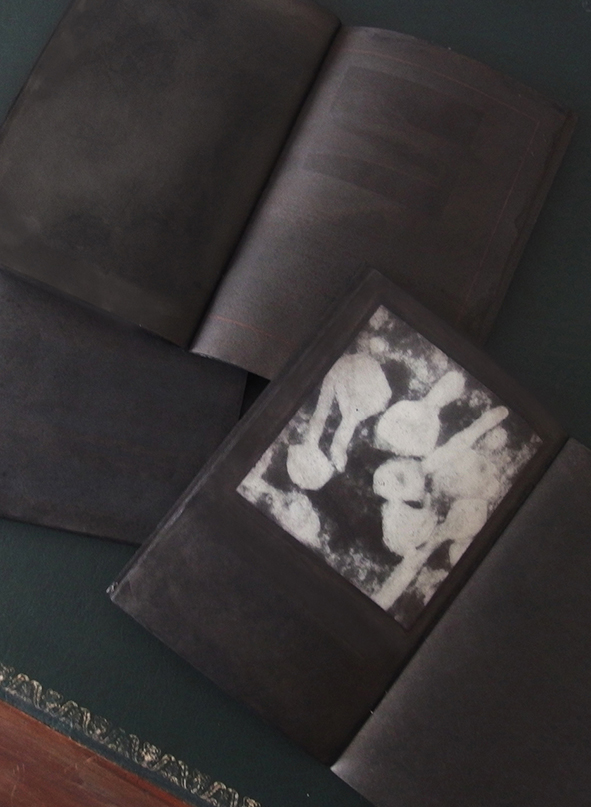
les Jardiniers, cur. Adrien van Melle - Nehama, 2023
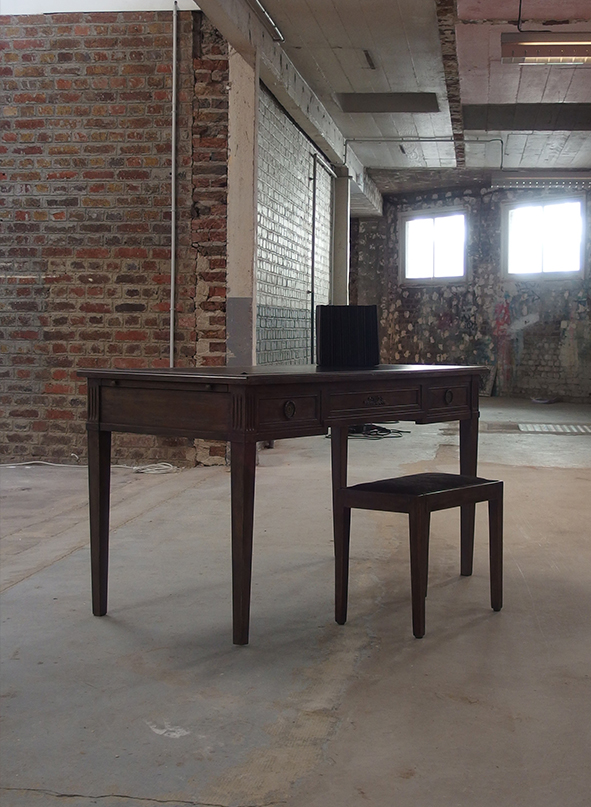
les Jardiniers, cur. Adrien van Melle - Nehama, 2023
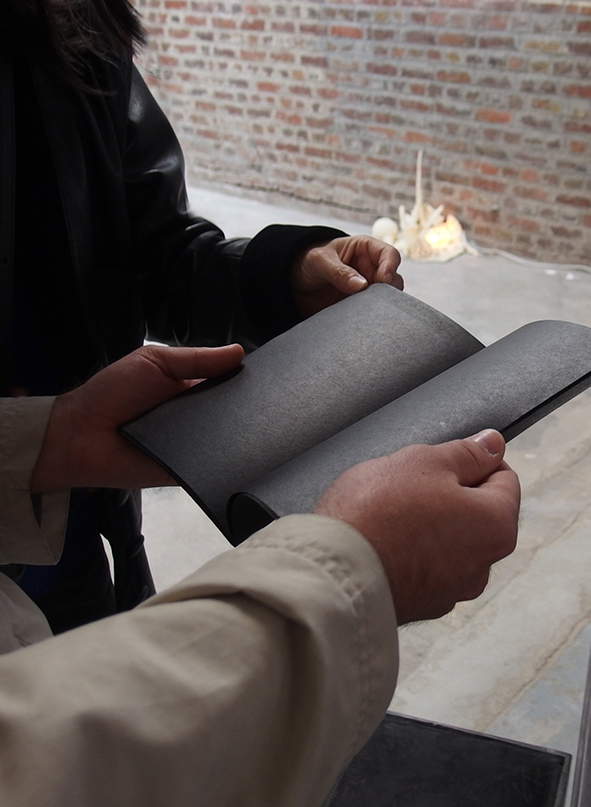
les Jardiniers, cur. Adrien van Melle - Nehama, 2023

les Jardiniers, cur. Adrien van Melle - Nehama, 2023
MATCHSTICK IMAGES
installation . matches and steel supports .
2023-2024
with the support of the Fondation de France and 6B
In the darkness, amidst a strong smell of sulfur, an installation is revealed, featuring several metal supports topped with a platform on which about thirty black matches are arranged. On these matches lies a printed image from old newspapers, hinting at a snow scene sparkling in the night. To make the image visible, one must sacrifice a match, and thus a part of the image; it can be glimpsed during the match's combustion. These images, which no one ever looks at, are impossible to retrieve from the immeasurable pile of past news archives, stripped of all captions here, reappearing for a brief moment before almost immediately slipping back into oblivion.


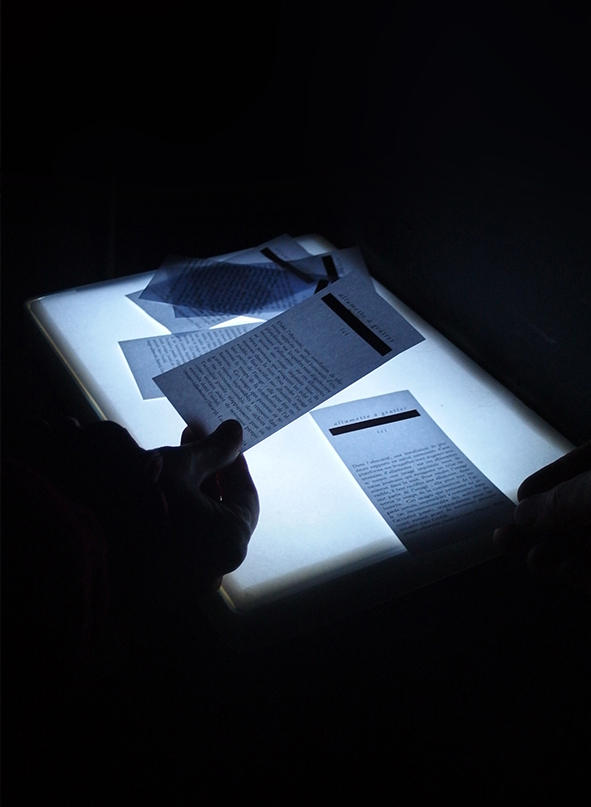

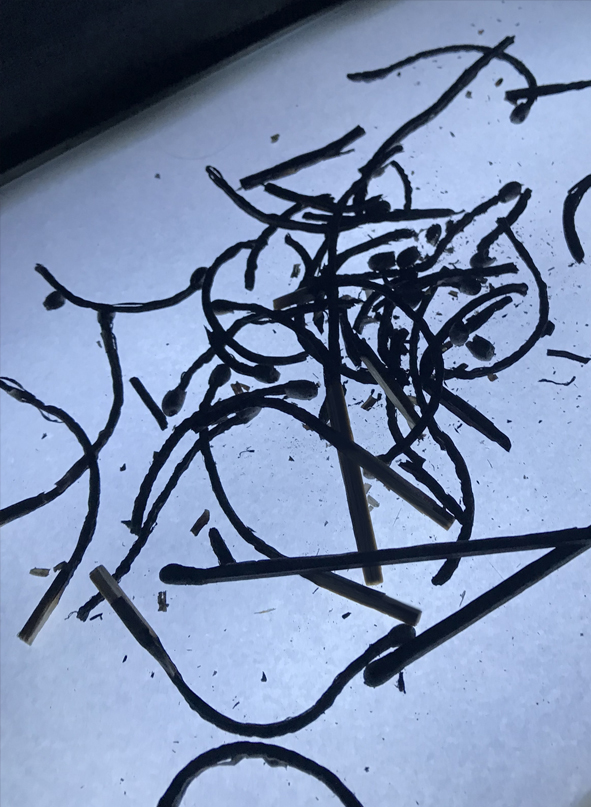
CHRONICLE OF HUMANITY
installation . touch screen .
2019
with the support of the city of Maisons-Laffitte
Chronicle of Humanity is a digital replica of the book of the same name published by Hachette in 1986. The entire book has been digitized and presented identically on a vast interactive page that can be accessed on a large touchscreen table. The content has been erased, except for the photographs: what remains is a succession of thousands of images without captions that recount the human saga in a silence that speaks to its fragility. These images also reflect an era, a way of depicting history, and the country from which the selection originated; they serve as models of representation. Often, visitors gather around this large luminous display, much like sitting around a fire where stories are shared. The images scroll by; most evoke nothing—faces without names, wars without dates—and sometimes one stands out; it’s pointed at, “I know that image”—and a story begins.
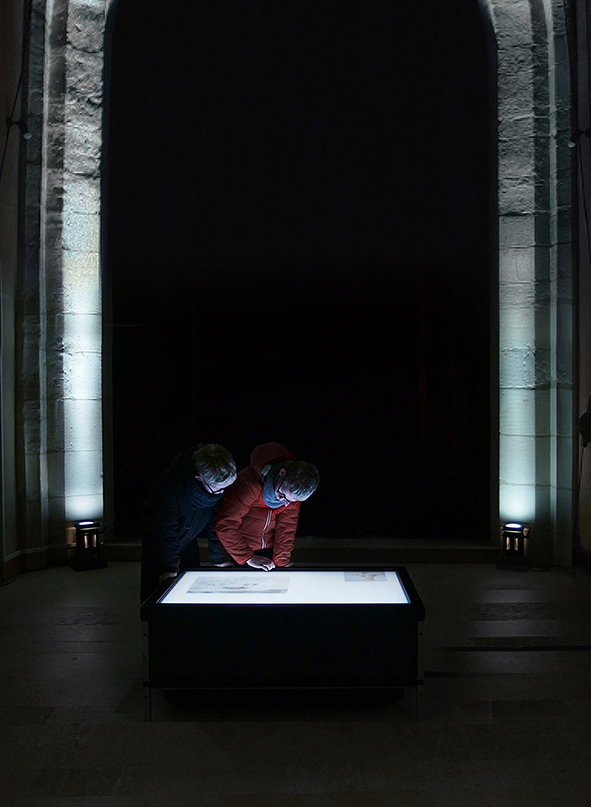
Former Church of Maisons-Laffitte - centre Ianchelevici, 2019

Former Church of Maisons-Laffitte - centre Ianchelevici, 2019
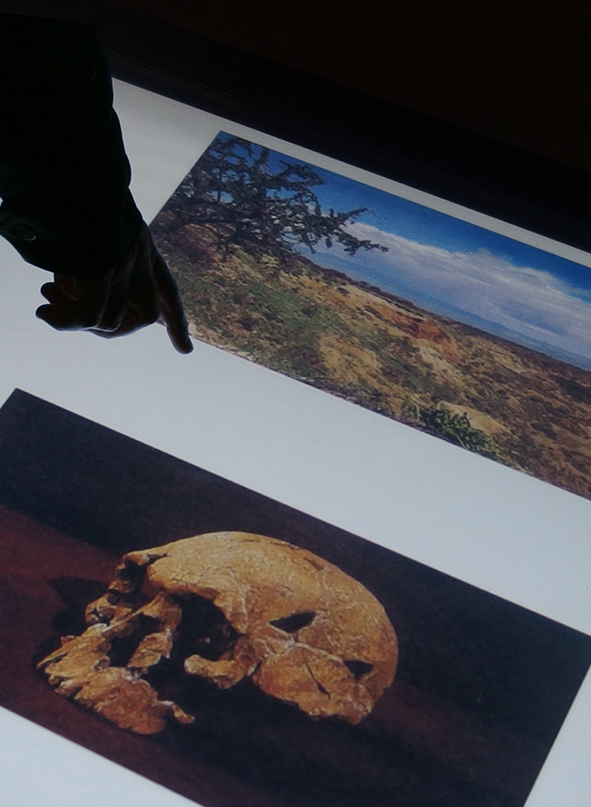
Botanique Bruxelles, cur Thierry Vandenbussche and Privacy Salon , 2020
SPECIMEN
book installation . unique
copies . 2016
with the support of the city of Montrouge
Specimen is an installation of learning manuals reproduced precisely (including papers, bindings, formats, and layout). Once these facsimiles are scanned, the content is erased, except for the photographs. By transforming these manuals into iconographic catalogs of unknown disciplines, what remains are silent picture books that embody the essence of knowledge, techniques, and crafts. They are arranged in a documentation setup and are available for public consultation. This initial participatory installation lays the groundwork for several reflections that will evolve into various forms, notably Chronicle of Humanity a few years later.

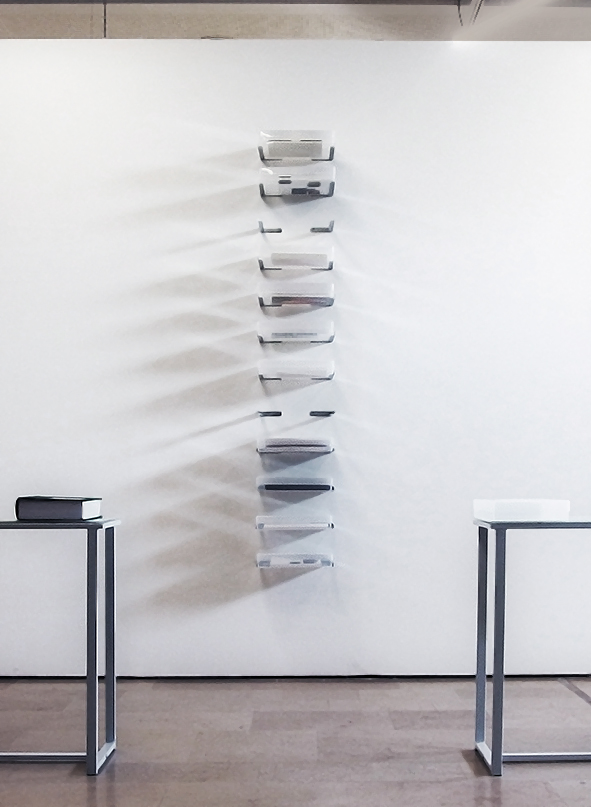
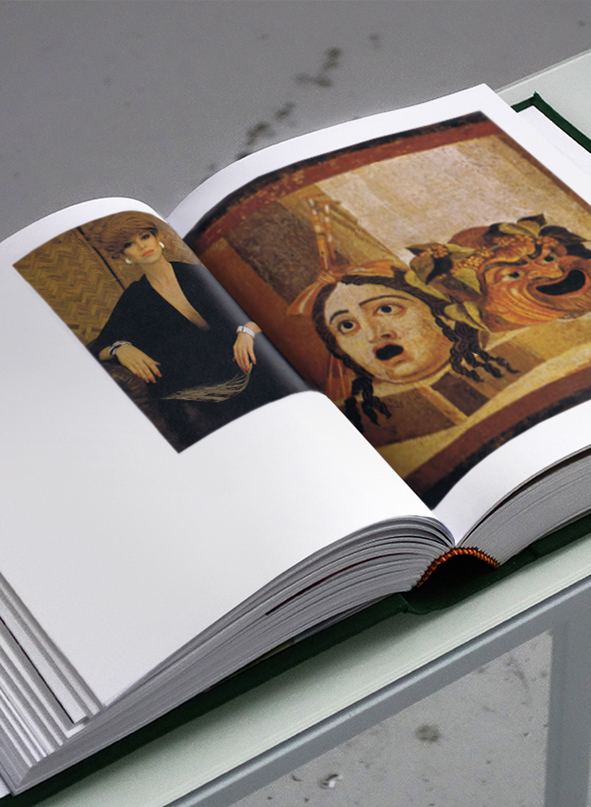
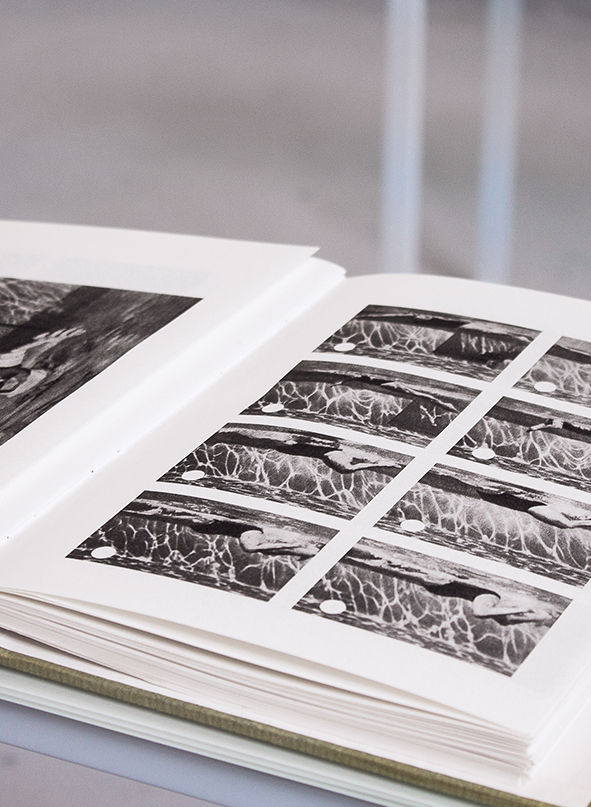
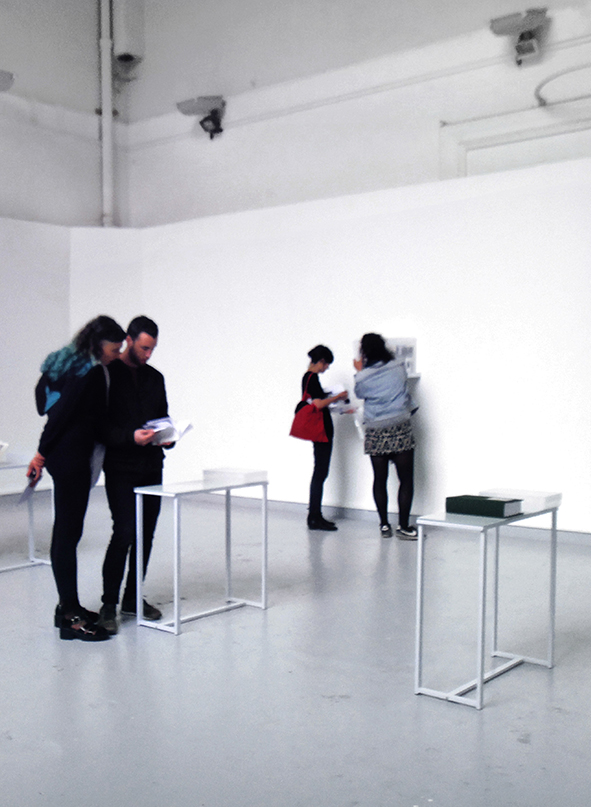
SYRIA TRAVEL
video . 14’30 . 2019
with the support of the city of Maisons-Laffitte
The video Syria travel presents the authentic account of a couple's family trip in December 2002 during Christmas. The narrative from this excursion is punctuated by gaps that the two protagonists attempt to fill in from their respective memories. The video features details of blurred images that are impossible to identify, with a wavering focus. At rare moments, a clear visual emerges when a memory is recalled with certainty. Although the Syrian conflict is never explicitly mentioned, it is continually implied. The narrator, who is pregnant, speaks of the pain of contractions during a grueling journey through the desert and her fear of losing her child, who has shown no signs of life since the beginning of the trip. This amnesiac narrative oscillates between a tourist visit to a ruined world heritage site, the tragedy of a country ravaged by war, and the personal story of survival and birth amidst ancient ruins.

Former Church of Maisons-Laffitte - centre Ianchelevici, 2019
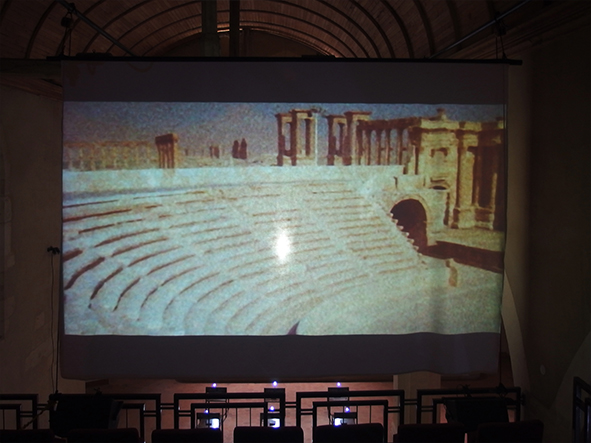
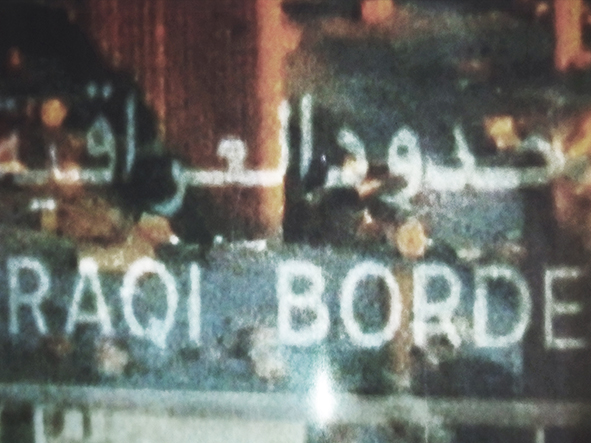
Former Church of Maisons-Laffitte - centre Ianchelevici, 2019
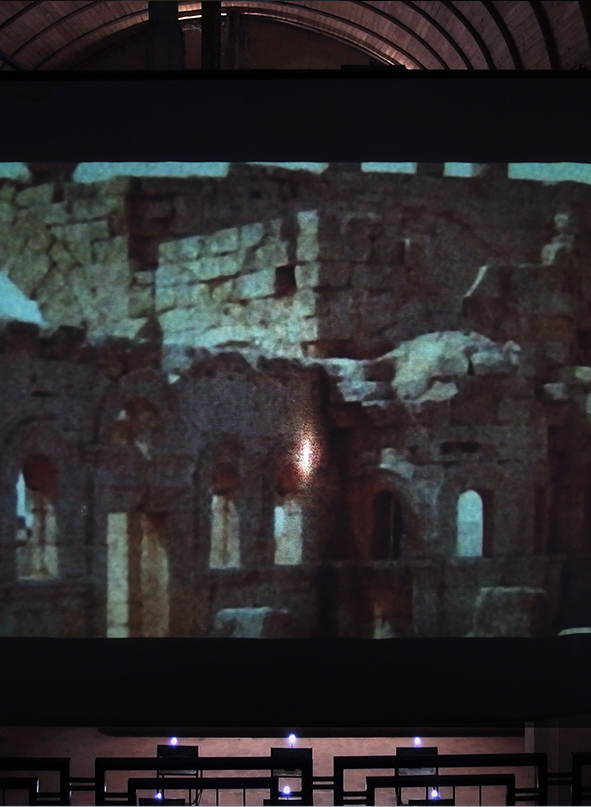
Former Church of Maisons-Laffitte - centre Ianchelevici, 2019
BREAD ARCHIVES
photographic prints on edible paper.
steel support. installation .
2020-2023
Bread archives is an installation of edible images printed on edible paper. These images are sourced from family photo albums that were discarded and rescued from the street. Once re-photographed and printed on the edible paper, the images are permanently destroyed, as originally intended by their owners. By consuming them, visitors experience these intimate photographs one last time, ingesting memories that have been abandoned and are now forever lost, becoming the last bearers of this erased memory. This installation proposes a strange and somewhat absurd gesture: to ingest an image—to be iconophagous—and each person reacts strongly and differently to this concept.
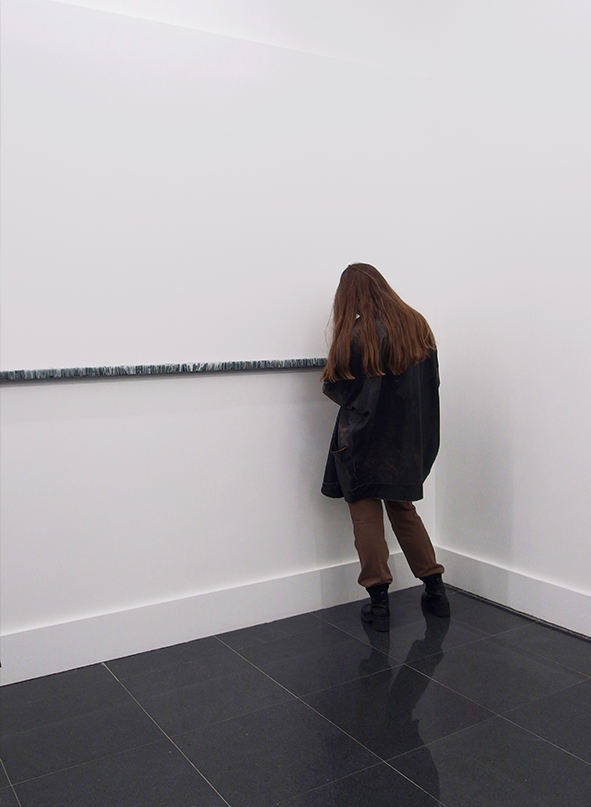
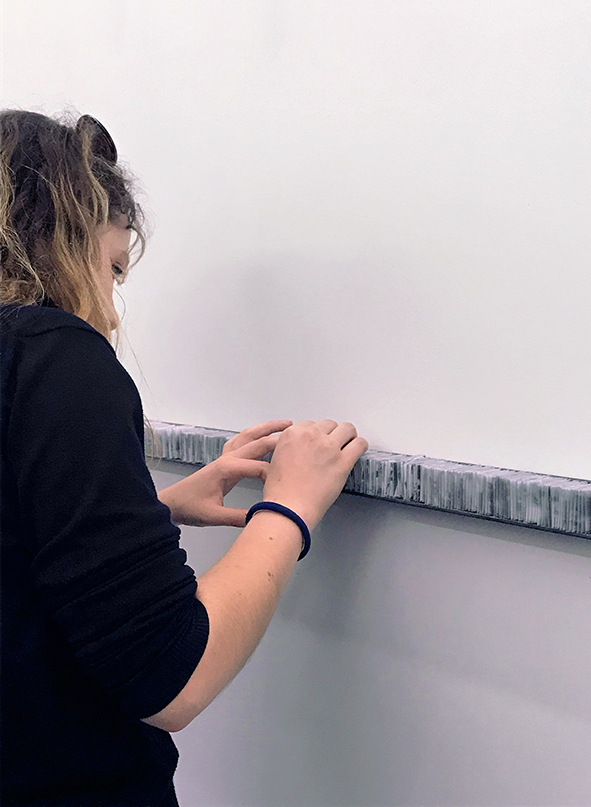
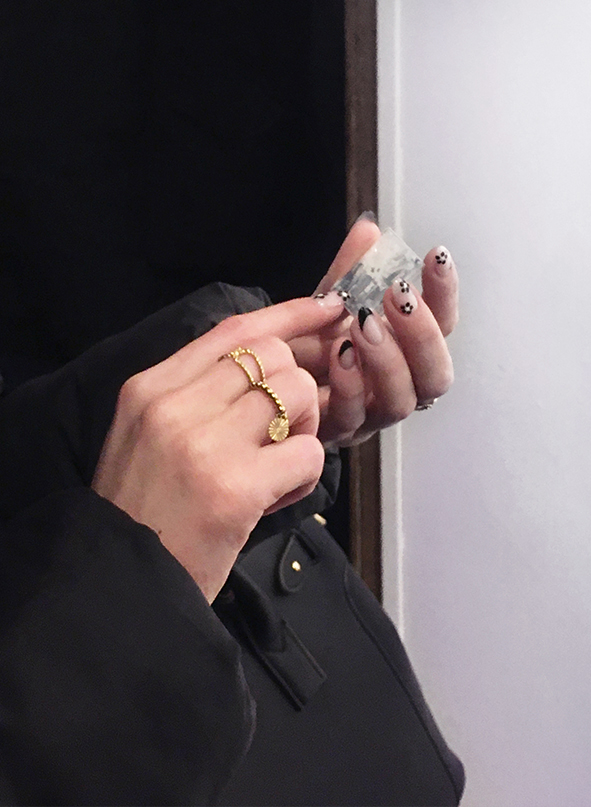
cur. Bruno Dubreuil and Bogdan Pavlovic, 2023
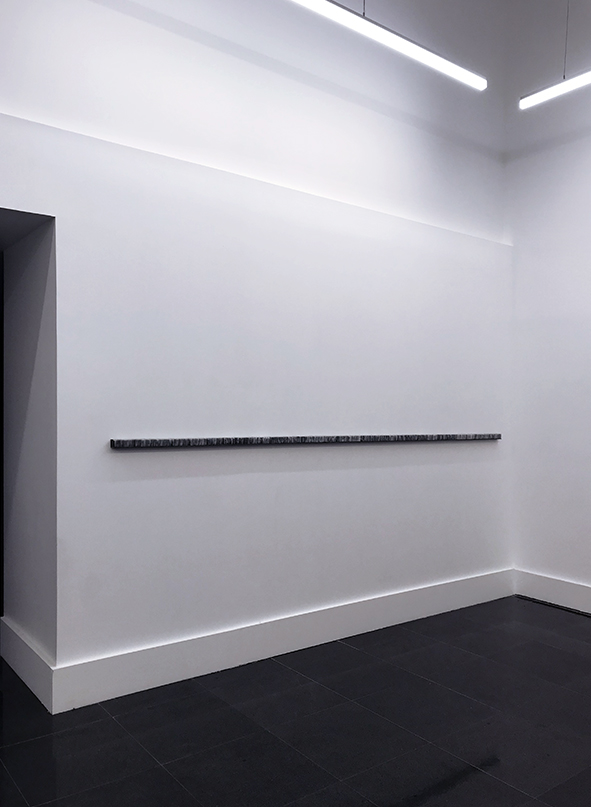
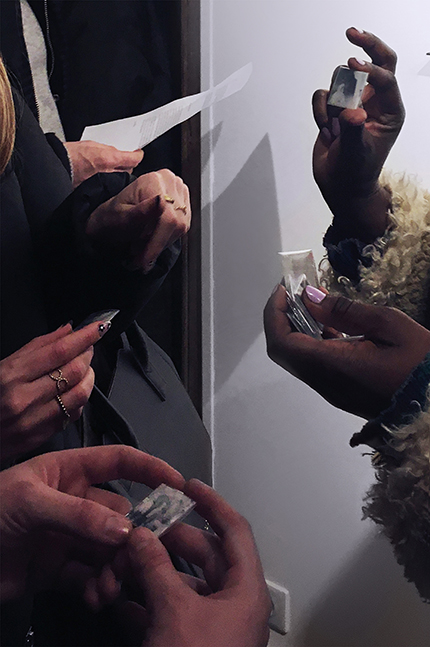
cur. Bruno Dubreuil and Bogdan Pavlovic, 2023
STARS ET DUSTS
book and installation . 2019
with the support of the city of Maisons-Laffitte
stars & dusts is a book comprising a selection of early 20th-century photographs. This iconography serves as a collection in which the sun, the moon, or dust specks (resembling spots in the sky) appear in the backgrounds of historic sites that are empty, in ruins, and abandoned. The conditions of preservation have sometimes left white, round marks. This selection elevates these specks and stars to the same level, representing two units of measurement for the infinitely large and the infinitely small—ultimately similar in appearance.
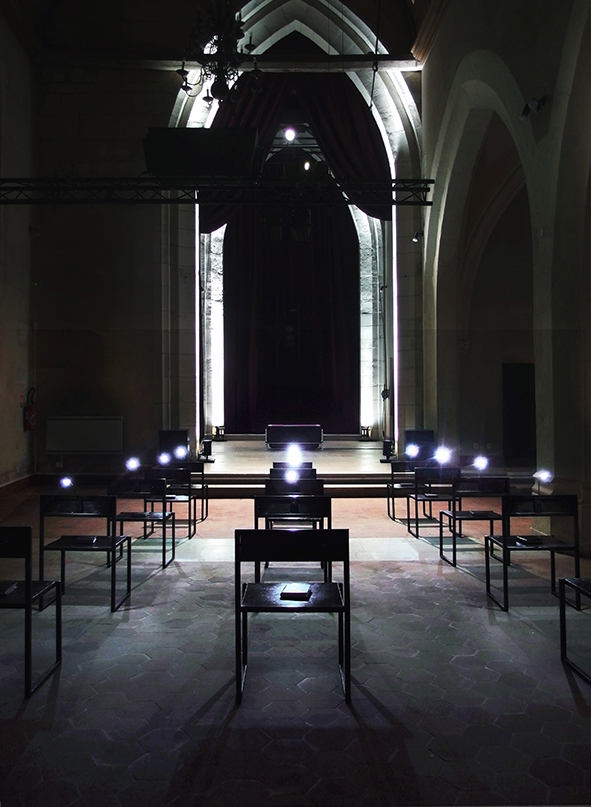
Former Church of Maisons-Laffitte - centre Ianchelevici, 2019
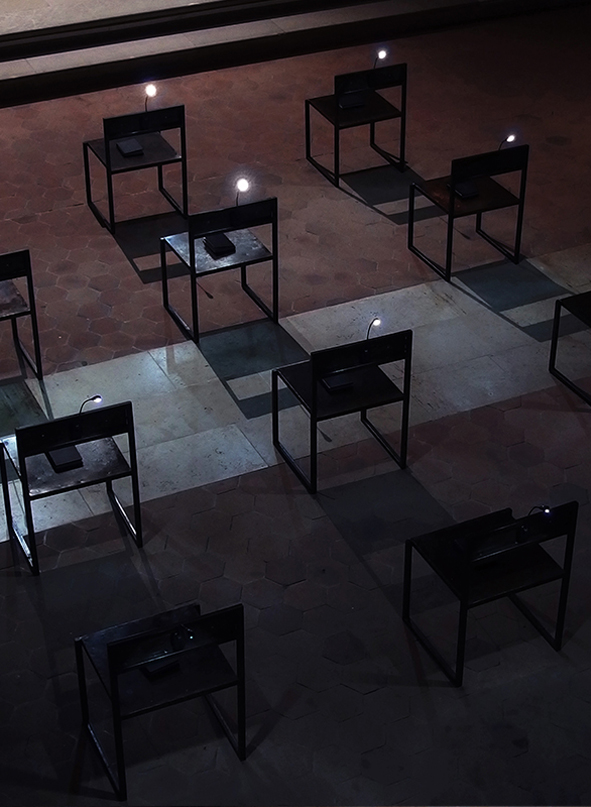
Former Church of Maisons-Laffitte - centre Ianchelevici, 2019
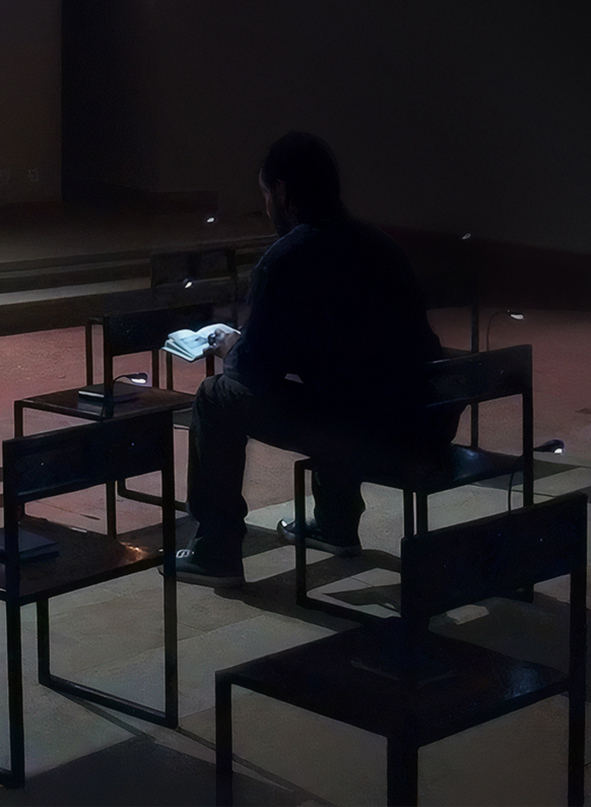
Former Church of Maisons-Laffitte - centre Ianchelevici, 2019
SINGULAR COLLECTION
paintings, variable formats, 2016
The work Singular collection consists of restoring a material reality, in the form of copies, to looted paintings that disappeared during World War II—lost and never found—by recreating them in color and their original format based on black-and-white photographic archives. These three copies represent three portraits: a religious figure, a minor historical actor, and an unknown individual. The selected paintings span different eras and styles, created by both famous and obscure artists. The reconstruction process was developed in collaboration with a copyist, Philippe Van der Linden, to imagine the colors of these lost paintings, invent coherent details, envision the formats, and capture the artist's intent in pixels. This long research effort aims to create inaccurate doubles of these works. They resist their disappearance through these fakes and survive as ghosts.
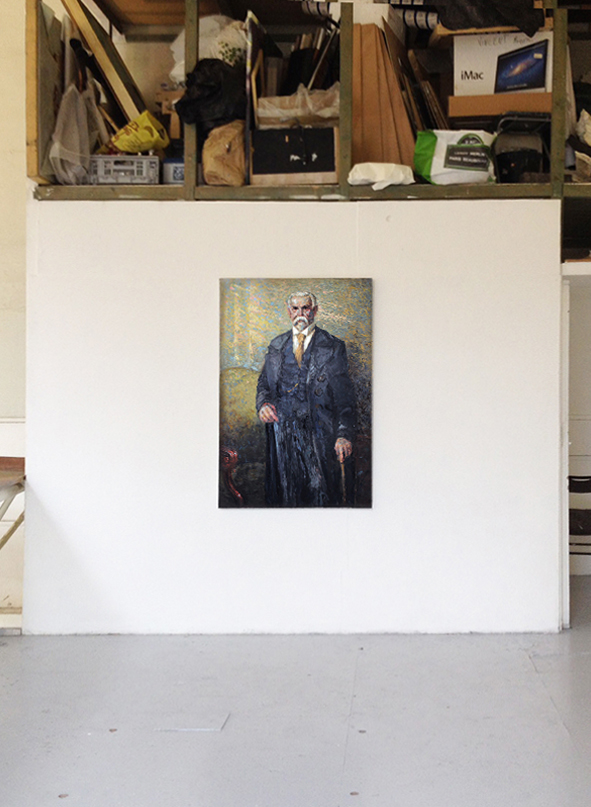
unknown format, oil painting on canvas, date and place of disappearance: 1945

date of creation unknown, 63 x 47 cm, painting on poplar wood,
date and place of disappearance: unknown c. 1939-1945.
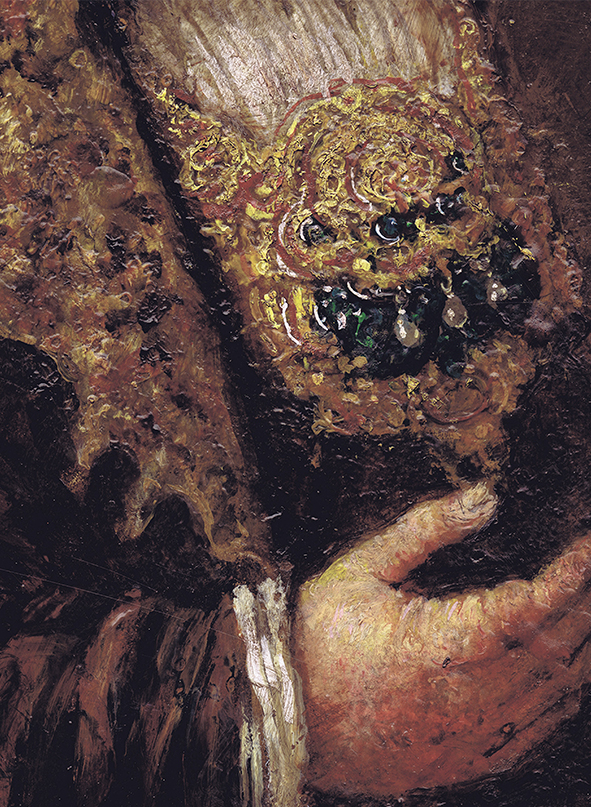
date of creation unknown, 33 x 24 cm, painting on beech wood,
date and place of disappearance: unknown c. 1939-1945
BRETSCHNEIDER, PRIVATE COLLECTION
research . conferences . publications since 2018
Fabulous Image|Sottobosco ⇲
Matin magazine ⇲
Johann Michael Bretschneider is a minor and obscure painter from the late 17th century whose work consists of a few rare paintings depicting galleries of paintings. Within these figures of academic style lies a barely formulated meta-work. His painted galleries are adorned solely with his own paintings, which were never actually created. He has never entered the history of painting (no publications). Bretschneider, private collection is a protean work that aims to conjure from nowhere a suddenly significant artist with 500 paintings from a mysterious fictitious private collection (which I have actually photographed in several locations across Europe, thereby becoming the sole holder of the iconographic fund of this meta-work) through texts, conferences, and online publications, while cleverly conducting a poetic and historical analysis. His work and place in art are re-evaluated through simple effects of cropping and editing—Isn't that how history is always constructed?—and this written work sheds light on a true-false history of painting.
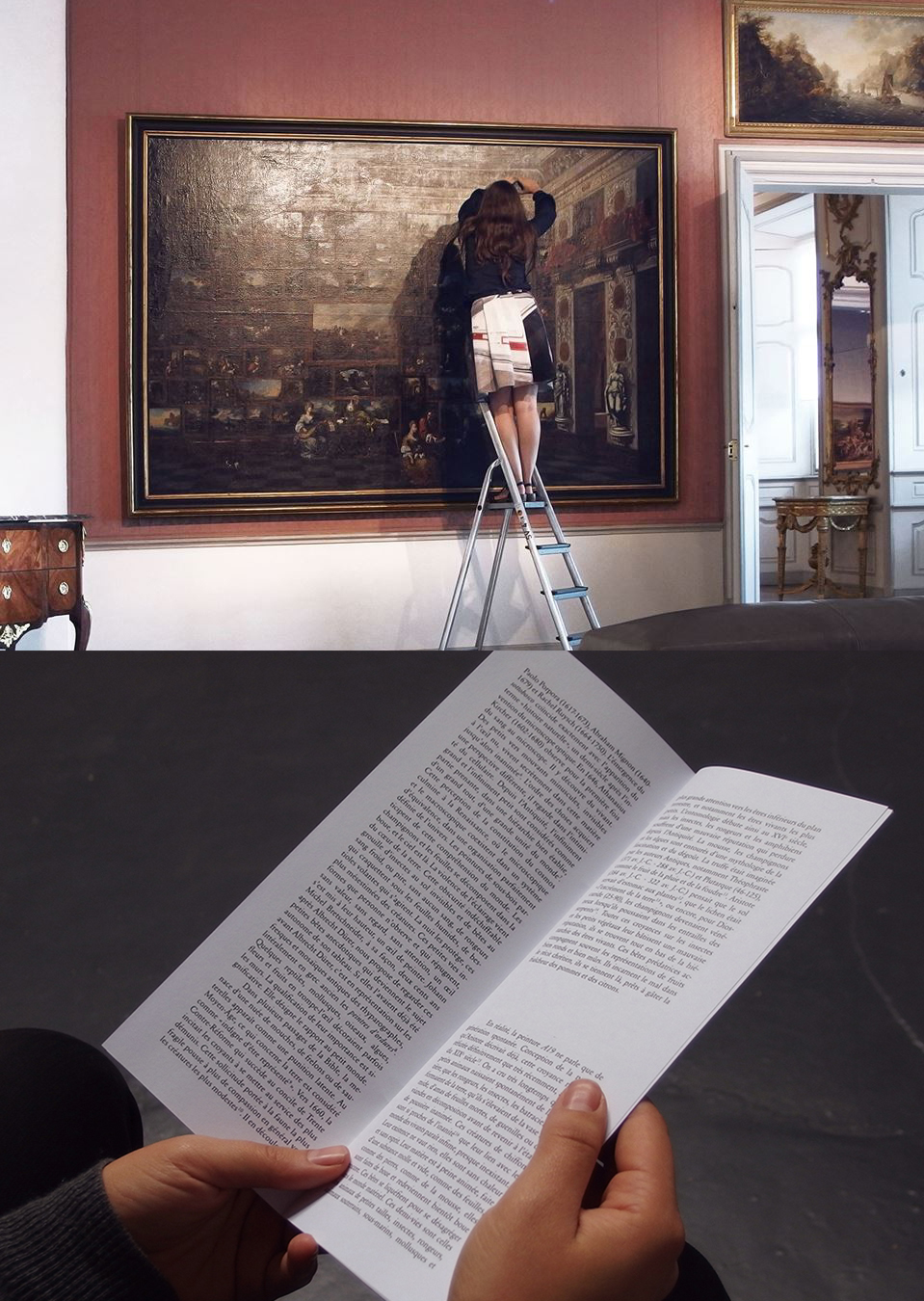
TEMPO DE L'ART
updates on the emerging art scene
radio show . since January 2023 .
as the host and creator of the show
instagram ⇲ •
apple podcast ⇲
Tempo de l’Art is a radio program that aims to invite young figures in contemporary art for a monthly discussion centered around current events. The guests include artists, curators, writers, and directors of exhibition spaces. This platform is intended to provide a high-quality listening experience for young artists, promote their exhibitions, and offer a moment for reflection on the challenges of contemporary creation. The show is broadcast on Fréquence Protestante, a secular and cultural radio station, as well as on all podcast platforms. It is recorded in the studio under live conditions and is not edited

with Rebecca Lamarche Vadel, director of Lafayette Anticipation
"les vagues", l'Onde, L. Camus-Govoroff,Élisa Florimond, Jerome Girard, Victoire Gonzalvez, Léo Guy-Denarcy, Alice Lejeune, Noémie Pilo, 2023
IN.PLANO
artist-run space . as co-founder .
member of the association and collective .
from 2017 to 2024
inplano.xyz ⇲
This artist-run space has hosted approximately thirty exhibitions and several hundred artists, curators, and art practitioners since its inception. As a research and production platform, it aims to disseminate and promote contemporary creation based on the principle of knowledge and resource sharing. From the beginning, in.plano has embraced its uniqueness, striving to create both a workshop and a genuine exhibition space. Notably, in.plano was invited to exhibit at the Salon de Montrouge in 2022 and at The Others Art Fair in Turin in 2018. The collective received support from the Fondation de France in 2023-24 for the production of several exhibitions with guest curators (Léa Djurado, Alexandra Goullier Lhomme, Adrien Elie, Noelia Portela) held at 6B, Doc, and Au Lieu. It also received a DRAC Île-De-France Grant in 2020 and was awarded the François de Hatvany Prize from the Fondation de France in 2018. The original exhibition space was destroyed illegally and irreversibly in 2022. (Libération article ⇲)
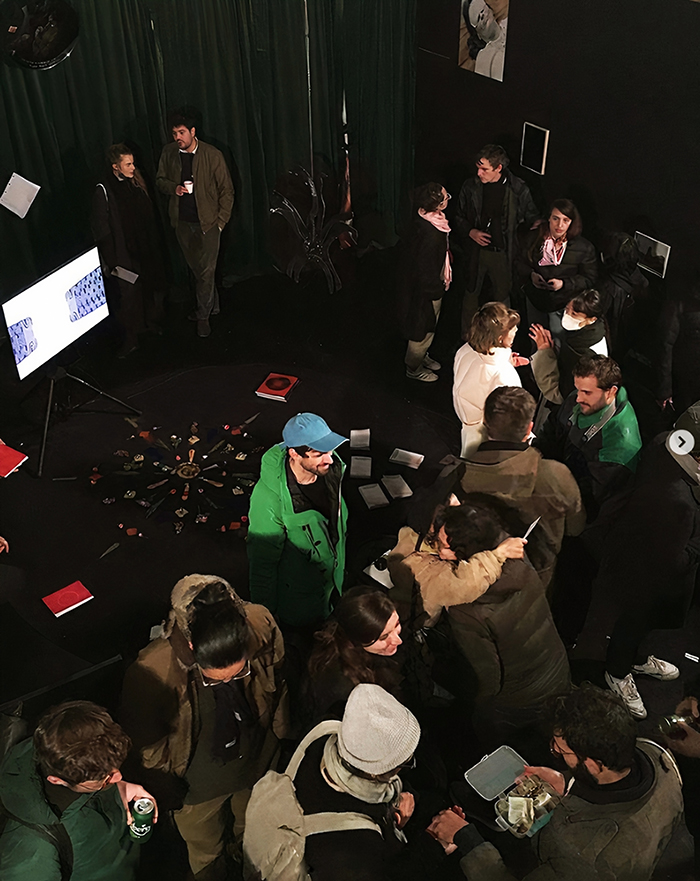
TEACHING
in higher education . from 2017 to present
The several courses primarily involve exploring a vast collection of documents (films, photos, texts, books, etc.) organized into different research topics on images and housed on a dedicated digital platform. Each year, this database is enriched with new topics, additional references, and documents related to current events. Patiently and meticulously compiled, this extensive collection serves as a foundation for the research behind the works presented here, with its branches and future additions hinting at what is to come.
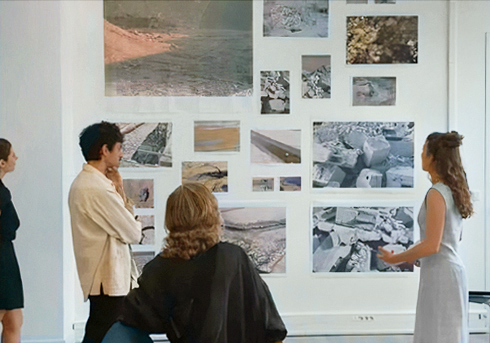
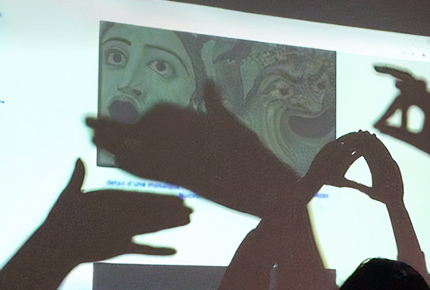
ECV 2021 / Bottom: for a brief moment, the students cast shadows on the projection of a course about moving images before cinema, particularly shadow theater,
Ateliers des Beaux-Arts Paris, 2021.
DATE(S)
curatorial proposal . posted exhibition .
as co-curator with Alexandra Goullier Lhomme and artist . in.plano . 2021
This year of the Covid-19 pandemic, 2020, has been a year of distancing, whether social, psychological, or physical. Date(s) aims to absorb this distance. It is a posted exhibition that seeks to bring the artwork back into the palm of the hand and shifts its experience into the intimacy of the home. Date(s) proposes a series of eleven encounters between artworks and their subscribers. Eleven artworks that will gradually add to and meet one another throughout the year 2021, forming a unique and variable exhibition that rejects the sole privilege of the sense of sight. Date(s) is an off-frame proposal. The artwork, and then the exhibition, are stripped of all their habits and present themselves naked, without any preconceptions, in unfamiliar
interiors. [...]"
curatorial text, continue ⇲
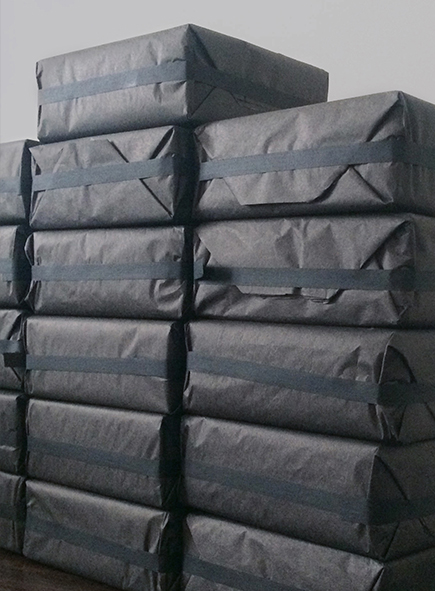
TEXTS & PRESS
In each of its positions, the material remains for one
or more moments,
les Jardiniers, Montrouge,
2023
What remains is the desk: a space of knowledge bridging learning and the one who weaves it, forming a structure for the world. The desk is authoritative; it is a figure—a place where we can cover up our faults and theories, a consultation space for a sick history, anticipated media ruins, in friction.
In a double movement, Lucie Planty oscillates between the act of extraction and the act of covering. There’s an irony here, similar to that of an archaeologist burying their findings to understand them better. Surely, there will be something left on the surface—a part of the image. What else might it have to reveal? There may be an abuse of language in our presumed archaeological or even speleological approach. Wouldn’t it be better described as a nameless science, akin to Agamben’s description of the iconographic and anachronistic practices of art histories viewed through Aby Warburg's lens?
Amid this slight disturbance on the surface, it remains that history is amnesiac—it forgets and reveals itself in half-words. Amnesiac because the stakes of memory have dissolved into the ink that covers the rest of the page; Babel and its library have melted away, history liquefied in the end. All elements are present yet confused, lost, and intertwined. Nevertheless, the artist brings forth a singular materiality—the material of old books of knowledge, that of a black desk, almost burned. The potential narratives materialize in charged objects that emerge before us, almost trembling. These pre-existing objects, conscious and repainted, serve as witnesses, densifying the notion of history within them.
In painting, a pentimento is defined as a covering meant to rectify the work, to make an element appear or disappear, or to modify it. We aren’t dealing with erasure; it’s not about regaining a primary state of absence. It’s about the effect of negative erasure, thus through covering. Lucie Planty, with her Historian desk, doesn’t propose answers but raises an important question that speaks to us, reminding us of our forgetfulness.
Date(s) / Bread archives
2021
The succession of images, delicate and slightly transparent, evokes a familiarity with old photographs, some of which are sometimes eroded by time. We think we already know the subjects and their poses. It's always surprising that people are confined within such tiny frames, isn’t it? And the archive pages, could they be ours? Ultimately, the question posed by the work is: if it is edible, does that mean we should eat it? Initially, we feel tempted, then we hesitate, and then we feel compelled again. Before realizing the absurdity of the act: to cannibalize the images and ultimately the people and the memory. To eat to make disappear, or to absorb ?
World as picture
2023
Digesting images. — Some deportees, on the final path leading them to the gas chamber, aware of their imminent end, ate the family photos they had managed to conceal during their arrest. Thus, in their last hour, and for a brief moment, they incorporated the memory of their loved ones before their own bodies were reduced to ashes. While nothing as tragic occurs in Bread archives, the same magical appropriation of the other is present. Each image comes from an original, unique vintage photograph, sourced from abandoned and anonymous family albums, now destroyed by the artist. These memories will become yours; they will mingle with your cells and remain within you. Who knows if, in a distant future, their trace will not be integrated into your memory?
Salon de Montrouge catalog
2017
Lucie Planty proposes certain hypotheses about images that carefully documented processes seek to demonstrate. Drawing from what is known as 'post-Internet' culture, she aims to re-engage with virtual exploration through the materiality of her research, establishing protocols for the resurgence or recreation of 'missing images.' This investigation serves as both a creative process and an artwork in itself, guided by specific
Going so far as to substitute works that have disappeared, Singular collection (2016) was developed with a copyist from archives of artworks looted during World War II, reconstructing a heritage from fragmentary references. More than just a memory of the lost piece—explored by Sophie Calle in Tableaux dérobés (stolen paintings) —this project embodies an apparition, a mystical phenomenon. While it doesn't directly address issues of the sanctity of images or iconoclasm, it draws on dogmatic practices of selection and destruction to create strategies that imbue, amidst the discontinuous flows from which they emerge and despite their questionable authenticity, a vibrant aura.
exhibition catalogue
Beyond heritage
Former Church of Saint-Pierre de Montmartre
2016
Singular collection [...] A priori, it is this work of memory to which Lucie Planty has devoted herself. She has chosen to narrate the story of artworks looted by the Wehrmacht in occupied territories that have never been recovered. It is her task to reconstruct these lost works and reactivate them. To this end, she guides us into a dizzying labyrinth reminiscent of Borges. Indeed, from the missing painting, at best, only a black-and-white photograph and an inventory note remain, mentioning the author and specifying the date, technique, and dimensions. Based on these documents, Lucie Planty invites a painter to interpret the work, as if it were a piece of music meant to be recreated at leisure. In a previous work, cathedrales.html, the artist collected reproductions of Impressionist paintings, completing the 'series' initiated by Claude Monet with his 'new versions' resulting from the whims of printers and the unpredictability of color reproduction. The ghost gallery, of which Beyond Heritage
Variation Media Art Fair
Cité des Arts
2017
Lucie Planty also searched the Internet to find traces of looted paintings from the occupation through images. Engaging a copyist, she reactivated them as one reconstructs crime scenes. Little is known about the Magdalene from her Private collection, neither the date of its creation nor the exact date of its disappearance. Yet, it is there, painted on poplar wood, as a consequence of its own disappearance.
Jeune Creation
2021
Last Century, which culminated after more than four years of reflection and waiting, emerged from a process of analysis, selection, and editing of images contained in the Italian newspaper La Stampa, now digitized and archived online. The work consists of one hundred booklets that chronologically trace international news from 1900 to 2000. The content, darkened by digitization, which prioritized textual form over visual readability, produces 'dead images' that are here dissociated from any text or context. Each photograph loses its purpose and its informative or illustrative status. They no longer testify to History, even though the digitization of these archives was supposed to provide better dissemination and understanding. In the face of this wall, a cascade of paper in relief, Lucie Planty invites us to manipulate and consult this collection in search of a possible meaning of History.
2017
« Filling the Gaps » exhibition catalogue
Our Shadows in Front of Us Fondation Ricard, Paris
2017
Fascinated by archives, the artist has presented a series of books in boxes on consultation tables for public access. Initially, these documents serve an educational purpose, ranging from swimming manuals to firearms guides. Lucie reproduces them as facsimiles, adhering precisely to the original content—from paper weight to image layout, with one exception: the text is removed. The ERR repertoire and the usage manuals bear the mark of absence, turning the reader into a spectator of an absurd scrolling of pages, immersed in a story either lost or in the process of being written.
Disappearance is further emphasized in her installation of postcards featured in the exhibition Our Shadows in Front of Us. Lucie Planty introduces a foreign element into a stereotyped image, creating a hiatus that underscores absence. These three images depict Pompeii, the Aral Sea, and a sculpture by Jean-Pierre Raynaud located in the Place de Paris in Quebec. Each location has faced a different form of annihilation. In Pompeii, the volcanic ash that engulfed it in 70 AD paradoxically revealed it centuries later. The spatial view of the Aral Sea symbolizes human destruction for economic development, which led to the diversion of the Amu Darya and Syr Darya rivers, the two that fed the small sea. Raynaud’s sculpture, ironically titled Dialogue with History, underwent a demolition 'of taste' staged in front of the press in a public square in June 2015. The artist carefully covers the image of this disappearance with gold leaf. In the style of the golden backgrounds of Byzantine icons, Lucie Planty sanctifies absence.
The aura conferred to the postcard—an easily reproducible representation that serves as a souvenir in museum shops—contains a narrative imbued with historical significance, highlighted by this golden burial. Much like Pompeii cloaked in ashes, this thin layer of gold both veils and reveals a story. An exhibition device accompanies these gilded postcards: a transparent column compresses the image, acting as an inverted pedestal. Ironically, the plexiglass compresses history and adds another layer of concealment, creating an intimate resurgence.
Through this clever ruse, the artist replays the process of revealing absence, orchestrating the viewer's reception.
about stars & dusts», transcribed excerpts
from the dialogue conference held
on January 19, 2019, as part of the exhibition
Carte blanche à Lucie Planty,
Former Church of Maisons-Laffitte
2019
about Syria travel,
transcribed excerpts
from the dialogue conference held
on January 19, 2019, as part of the exhibition
Carte blanche à Lucie Planty,
Former Church of Maisons-Laffitte
2019
She struggles to articulate her intrinsic experience of waiting for a child, even as the images before us and her dialogue with the man who reconstructs her memory of his journey unfold. What we see and hear relates to a country that has become a terrible and inaccessible ruin—Syria. There is a particular emphasis on Palmyra, which has suffered dreadful iconoclastic destruction, where the director of Eastern Antiquities was assassinated, being the last man on earth to speak Palmyrene, a Semitic language he alone knew. I wish to evoke the Socratic method, a philosophical process that helps one 'give birth' to ideas. It is likely not a coincidence that we hear the account of a woman approaching her delivery while in a critical situation, unable to articulate the torment of waiting for a child amidst the narrative of a Syrian journey. The Socratic method truly relies on one’s interlocutor, proposing a journey with words while placing them in a challenging position. This allows them to let go of what they cannot bear, confronting a truth they may not want to face.
Variation Media Art Fair
Cité des Arts, 2017
Posted exhibition, a curatorial proposal
by Alexandra Goullier Lhommme and Lucie Planty curatorial text
in.plano, 2020-2021
The year 2020 will have been the year of distancing, whether social, psychological, or physical—the touch has become the forbidden sense. One and a half meters to protect oneself, but especially to protect others from everything that might emerge from us. The space between things and beings has become a palpable necessity: smooth surfaces that contain, enclose, and hold bodies; barrier gestures that become new habits.
Date(s) seeks to absorb this distance. It is a posted exhibition that aims to place the work back in the palm of one’s hand and shifts its experience to the intimacy of home. A multi-sensory (ap)prehension, Date(s) proposes a series of eleven encounters between artworks and their subscribers.
Date(s) is an exhibition that overturns its own codes and allows itself to borrow others, such as those related to the vocabulary of sending—to play with. On one hand, it is entirely free, capable of transcending boundaries, creating its own circulation networks while at the same time being subjected to weighing, postage, and cancellation. Affiliated with Mail Art, Date(s) is a deliberately fragile balance between the address of a contained/containing message and the relinquishing of the sending and receiving, including other rules and individualities. It is a collection of determined intentions and sharpened attentions, a relay passing from hand to hand, slipping through interstices, playing with constraints, and rebelling against frameworks.
“Each Mail Art work is a weapon brandished against the Great Monster that owns the castle and separates us from one another, just as we are. (...) When we were painting, we could speak of sensitivity, beauty, vision, skill, etc. But when we knock on the Monster's door, what really matters? The answer is simple: what matters is the force with which we knock. How can we measure this force? By the echo we produce, obviously.” Ulises Carrion in “Mail Art and the Great Monster” exposes the position of Mail Art against a Great Monster that is never explicitly named but seems to embody various Institutions. Date(s) is a series of discreetly subversive gestures that builds a network of micropolitical utopia through a series of one-on-one encounters.
Date(s) mimics the sensation of first meetings, romantic encounters where one faces the unknown, where one desires, idealizes, and sublimates those one is about to meet without knowing if disappointment or revelation awaits. This precise moment where the image confronts experience. Date(s) proposes a series of blind dates between a work and a body. “Blind dates” where one agrees to be surprised, to be guided—blindly—by the works. Subscribing to Date(s) thus signifies a romantic commitment throughout the year 2021. A commitment that will emerge eleven times and of which the subscriber will have no clues, except for the few words that have just passed.
Date(s) is above all a secret. A confidence between subscribers and artists, between you and us, between you and me, between those whose invisible links will be woven through this project. Far from hyper-visualization and the virtuality exacerbated by the year 2020, Date(s) aims to be tied solely around the intimate experience of the work. Not taking photographs of the works, not disseminating photographs of the works—neither to loved ones nor on social networks—is a sine qua non condition. Date(s) will therefore be reserved only for those who subscribe and for those with whom they will share their secrets solely through narrative or the transmission of physical works without any intermediary. A secret that spreads a dull rumor around it, that stirs the desire for knowledge, that awakens the almost childish wish to receive a surprise, to open a gift, a letter from a lovestruck admirer, the serenade of an artist.
Lucie Planty's Magic
Viens Voir, 2024
Images, especially photographs, can sometimes resemble mirages. The reality they evoke may feel opaque or out of reach. When we contemplate an image, it’s hard not to form a belief in an original source from which the image might have sprung. This belief is skillfully exploited by press, advertising, and propaganda images, all of which imply a perfectly credible and fixed original for everyone to trust. And so, we easily fall for the illusion. But why is there this misty layer of opacity in photographs? In ancient times, images were "extracted" from the material itself. The image had to seem as though it emerged naturally from the depths of the rock. These images were carefully chosen and placed in hard-to-access or labyrinthine spaces. The true “original,” then, resides more in the obscure activity of matter and its transformation. It becomes difficult to speak of an original in the sense we understand today. In this light, contemporary artists—especially photographers—continue to generate their work in this manner, driven by a vital creative force. Whether it’s a portrait, a landscape, or a street scene, they work from surfaces coated with silver salts, pixels, or other materials, and push the boundaries of the unknown. New exploratory horizons open up.
Lucie Planty is an artist deeply engaged with the questions of archives and memory—their vanishing, and their rebirth. To her, every image is a haunting, or a ghost of an untraceable original. The notion that history forgets itself is something she knows well. There is a kind of magic in meeting an artist who exercises great fluidity in her artistic practices, her thinking, her modes of existence, and thus embodies a constant openness to others. This is at the core of her work. In addition to numerous exhibitions, art installations, and books, she is also the creator and leader of the artist platform in.plano, an independent exhibition curator, teacher,
Our encounter aligns with her artistic approach. A conversation takes shape, references intersect, new narratives are constructed. This method of dialogue is not surprising with this artist, who always leaves room for others to act, to reflect, to make new gestures.
In the work Last Century, 100 sheets were selected from a time span of 100 years from the digitized archives of the newspaper La Stampa. She selects them and presents them in a vertical wall arrangement, without their text, and in the degraded state of images corrupted by scanning and digitization.
The digitized originals of La Stampa’s photographs are indeed totally degraded, but they have not entirely disappeared. The visual nature of this work now depends on a circulating relationship with visitors. Therefore, it does not simply invite passive observation from the viewer. If all these press images, meant to inform us visually on a daily basis, are erased, deteriorated, they are, in the present moment of the visit, returned to us, and this alteration becomes our shared concern. (cf. Restitutions, Georges Didi-Huberman p. 277 Penser l’image, Ed. Emmanuel Alloa. Les presses du réel.)
[...]In another of her works, Images of History, archive cabinets are filled with grayed-out and darkened visual documents for visitors to pull out themselves, from the shadow of this falsely museum-like or library-like classification. They create their own editing on a wall, following their own narrative combination.
Or in another installation, a false workspace named The Historian's Desk holds dozens of booklets, each different. The images are charcoal-like, as if burned or turned to ash. Visitors will invent their own ongoing or future research. The artist thus places on this "desk" the sensation experienced during any research in bookish or archaeological archives, that of plunging into the night of knowledge. Lucie Planty creates poetic artistic subterfuges of great beauty to subvert the intimidating authority of the Historian's Desk.
Another work presents training manuals and brochures of artisanal disciplines that have now become unknown to us. Their relevance has faded over time. Yet, at the time, they were models to follow, essential booklets. Because they are voluntarily deprived of context by the artist, and installed in a beautiful setup, they find today, despite the temporal shift, an unexpected audience.
The approach will continue and not stop there. In 1986, Larousse published a kind of general history encyclopedia. In Chronicle of Humanity, Lucie Planty removes the texts from the images. She installs them in a lightbox that can be scrolled. Faces without captions, wars without dates, paintings without authors—they scroll by until some people pause their scrolling. At certain moments, they recognize images that were part of their childhood knowledge. They are then, for a brief moment, with "their" images and "their" invisible dreams. Once again, a restitution.
The story will extend when visitors find, in exchange, an alternative way to view and use the exhibited works. They will then attribute a new aura to the images, one that had disappeared with the passage of time, but also due to the mistreatment of images by brutal machines.
Other visual adventures will reveal themselves even more audaciously. These works are often the result of long, historical and visual investigations spanning several years. They lead us into the labyrinth of disappearances.
Among many others, one particularly moving piece is The Private Collection. It is a research project on the looted artworks from territories occupied by the German army during World War II. These artworks were never recovered. All that remains are faint traces on the back of inventory cards, a few very vague indications, and some poor-quality black-and-white photos. With the help of a restorer who is also a renowned copyist, Philippe Dutilleul (artist name: Philippe Van der Linden), they together create a fictitious color reconstruction of the lost works. A false copy of the paintings is made, oscillating between reality, hallucination, and documentation. But why turn to a copyist?
It is worth noting that the tradition of copyists is very old. To demystify the disorientation, or even discouragement of researchers regarding the diversity of inventions by copyists when executing their copies, philologist and medievalist Michel Zink explains the reasons. In his field, the Middle Ages, manuscripts were necessarily fluid, necessarily uncertain, necessarily 'false.' The distortions could be considerable, and the originals often impossible to find. All writings, before the advent of the printing press, were never guaranteed to be exact. The processes
In this way, the original can disappear, in a sense, an incalculable number of times. And, to further complicate research, all these versions were often scattered across the four corners of Europe or the world. Lucie Planty thus reuses a very ancient method to copy/invent an original, starting from the tiny clues at her disposal. She thus preserves an ever-active, ever-living trace of this memory that was so brutally looted.
This work is so astonishing, destabilizing, and beautiful that its story is worth telling. The narration itself may not be surprising, as all of her work evokes a story that will peel away like skin from the matter it originates from. This installation was presented in 2023 at an exhibition in Paris, at La Ruche, bringing together several artists. It was titled "The World as Image," curated by Bruno Dubreuil and Bogdan Pavlovic. Lucie Planty placed numerous black-and-white photographs, which she had miniaturized, on a longitudinal display fixed to the wall. Neatly arranged like in a mini-library, they are offered to the public to eat. A small transparent plastic envelope, which must be removed before consumption, protected the photographs. The artist collected photos discarded on the street. They were destined for the trash. She selected the photographs, photographed them, and miniaturized them. She then had them printed on edible wafer paper by a specialist. Finally, she returned the originals to their intended fate: disappearance. Thus, they have disappeared twice—once through the fate of the trash and then through us. The ingestion is a conscious act. The gesture takes place in a public context, ritualized by the exhibition's setup. So, devoured on-site... or not. In my case, I took a small handful of photos and chose two. I returned the others to the 'photo library for eating.' I brought them home and, like a squirrel, I stored them so well that I lost them.[...]
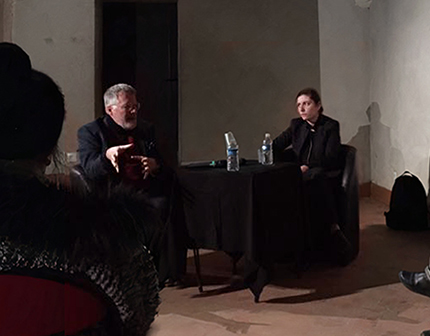 ⇲
⇲

of Lucie Planty, Isabelle Mangou, Viens Voir, 2024
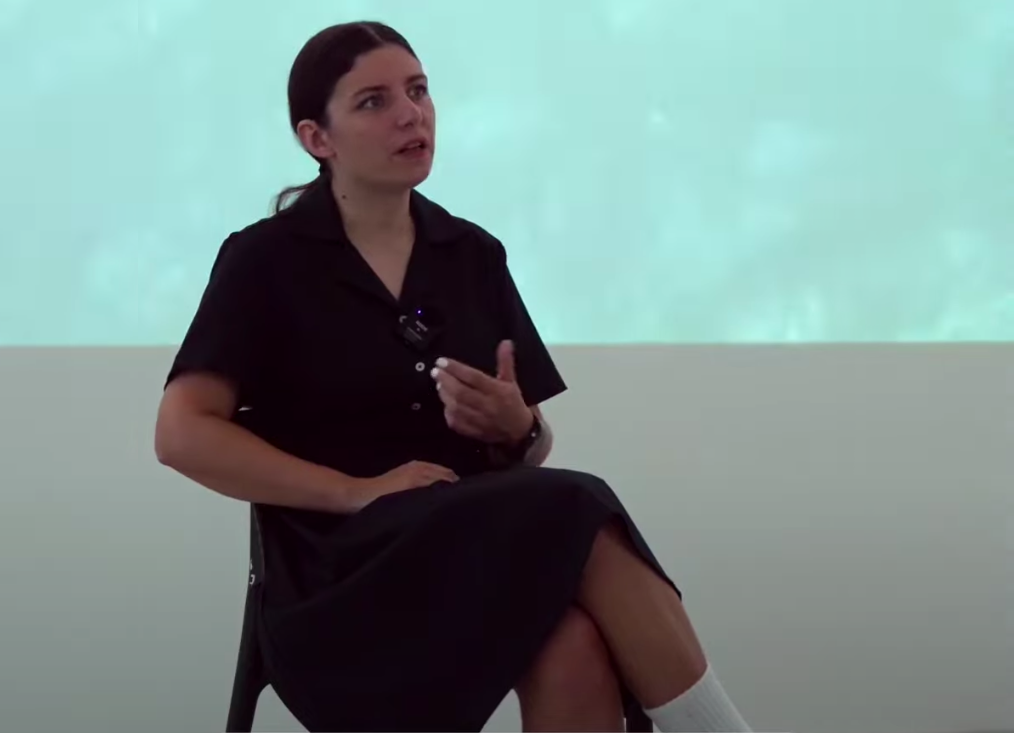 ⇲
⇲

WRITTEN
BIOGRAPHY
Her work has been exhibited internationally, including in Singapore (2024), Colombia (2023-2022), Italy (2018), Belgium (2017), Ecuador (2016), China (2015), and the Czech Republic (2014), as well as in various French contemporary art institutions.
Since 2017, she has been teaching in various higher education institutions, offering historical, theoretical, and practical courses on images and their interpretations. She co-founded the artist-run space in.plano in 2017, an exhibition and production venue, which received the François De Hatvany Prize awarded by the Beaux-Arts de Paris (2018) and support from the Fondation de France (2023–24). In 2022, she launched the radio show Tempo de l’art, which she hosts monthly, discussing current topics related to visual artists. In 2024, she joined the collective Oblivion, a research group focused on a digital platform dedicated to worldwide lost artworks — whether missing, stolen, damaged, or destroyed.
siret 539 036 269 00030
1990 (France)
• Scrying Frames, INSTINC Singapour, solo show, 2024
• Slices of time, INSTINC Singapour, work in progress exhibition, 2024
• From Ears to Mouths, cur. Léa Djurado, in.plano, 6B, 2024
• Making image, cur. Espace Fine, Michel Journiac gallery, 2024
• Non-lieu, Au Lieu, 2023
• In each of its positions, the material remains for one or more moments, les Jardiniers, cur Titi M. Cerina and Adrien van Melle - Nehama, 2023
• in situ Bazancourt Festival, House of the General Council of Songeons, 2023
• Trazando Dialogos, Alliance Française of Bogotà, 2023
• Trazando Dialogos, Un Nuovo error gallery, Medellin, Colombia, 2023
• World as image, La Ruche, cur Bruno Bubreuil and Bogdan Pavlovic, 2023
• Sentimental Place, Longue Vue Gallery, 2023
• Addresses, mail art, Portland, USA, Brad Adkins, 2023
• Salon de Montrouge, in.plano collective, cur. Work Method (Guillame Desanges and Coline Davenne), Beffroi de Montrouge, 2022
• Screening as part of Memories of MesaLendit, Premier film Festival, 6B, cur Alice Narcy and Halldora Magnusdottir, 2022
• Biennial of Artist's Books, Museum of Contemporary Art of Bogotá, 2022
• Circades, 6B, cur. collectif Espace Fine, 2022
• Contemporary Book Biennale, Bazancourt, festival in situ, 2022
• A title too long, Motoco, Mulhouse, cur. Shqipe Gashi, 2022
• Tomorrow, and tomorrow, and tomorrow, Jeune Création Gallery, Fiminco Fondation, 2022
• Emergency Issues Biennale, virtual exhibition, CCALF, 2022
• Alternative party, Cahier central, cur. Alexandre Barré, 2022
• Floating I, in.plano, 2022
• Apuntes de nuevas propuestas franco-colombianas, Galerie Doce Cero Cero, Bogota, Colombia, 2021
• Jeune Création, Fiminco Fondation, 2021
• Date(s), artist and co-curation with Alexandra Goullier Lhomme, mail art exhibition, 2021
• Blue in green, in.plano, 2021
• The Gold Coin, with Florian Schönerstedt, cur. Mo Gourmelon,
• Sharp, the dawn, in.plano, 2020
• Magical Objects, Maison de L’Ours, cur. Kristina Solomoukha and Paolo Codeluppi, 2020
• Contemporary book Biennial in rural areas, Hauts-De-France, Bazancourt, 2020
• In Situ Festival, Former church of Bazancourt, cur. Ouvre Les Yeux, Bazancourt, 2020
• Île-Saint-Denis open days, 2020
• Mensch Maschine, Botanique, Bruxelles, cur. Thierry Vandenbussche and Privacy Salon, 2020
• The Fool, Temperance, The Pope, and The Sun, in.plano, cur. Adrien Elie, 2019
• Carte Blanche to Lucie Planty, solo show at the former church of Maison Laffite, 2019
• in.plano xyz, in.plano, 2019
• Premiers Films Festival, Jardins Denfer, cur. Alice Narcy, 2019
• Decompression Room, in.plano collective, The Others Fair, Artissima, Turin, 2018
• Cinema, film screenings, in.plano, on the occasion of the open house at the workshops of Île-Saint-Denis, 2018
• Blind Collector, in.plano, 2018
• CRAC Biennial of Contemporary Art (Contemporary Artistic Creations, Realizations), House of Visual Arts, Champigny-sur-Marne, 2018
• O p e n i n g, in.plano, Île-Saint-Denis, 2018
• Our Shadows in Front of Us, Ricard Fondation, cur. Collectif Basalte, Paris, 2017
• Felicità 17, Palais des Beaux-Arts, Paris, cur. Joan Ayrton, Paris, 2017
• 62e Salon de Montrouge, cur. Ami Barak and Marie Gauthir, Beffroi de Montrouge, Montrouge, 2017
• Nouvelle Collection x Do Disturb festival, Palais de Tokyo, cur. Sarah Nefissa Belhadjali, Paris, 2017
• Variation Media Art Fair, Cité internationale des Arts, cur. Dominique Moulon, Paris, 2017
• Bibliothèque Estudiantine #9, Cabinet du livre d’artiste, Rennes, 2017
• Mythologie.s, La Vallée, Bruxelles, Belgique
• 4 Art Schools in the Box, Box 31 (Marie-Ange Guilleminot), Paris, 2017
• mythology.ies, La Capella, cur. Epopure Paris, 2017
• Tenacious promises, magnificent derision, La Station — Gare des Mines, cur. Thomas Malenfant, 2017
• Homeostasis Lab, the Wrong Biennale, 2017
• Grand Prize of the Bernard Magrez Cultural Institute,
• Recombinants, ART-O-RAMA International Contemporary Art Fair of Marseille, cur. Madja Edelstein-Gomez, 2017
• AMMA prize, Panthéon-Sorbonne for Contemporary Art, Bastille design center, Paris, 2017
• Rob a Robe, with Nouvelle Collection by Sarah Nefissa Belhadjali DOC, Paris, 2016
• Nouvelle collection, cur. Sarah Nefissa Belhadjali, Paris, 2016
• Rock-paper-scissors, Iconotexte, Cneai Chatou, Collectif g.u.i, Chatou, 2016
• Beyond Heritage, Former church St Pierre of Montmartre, cur. PaP BdA Sciences Po, Paris, 2016
• We've never been this close to the middle, Itchimbía Cultural Center, Quito, Equador, 2015
• A bazaar in the Bazaar in a bazaar, Bazaar Compatible Program, China, 2015
• Possibliothèque, Offprint, 2014
• 26e Brno Biennale, Brno, Czech Republic, 2014
• Famillies, Œil du Huit Gallery, Paris, 2010
• Support grant for the collective from the Fondation de France awarded to in.plano, 2023-2024
• Winner of the Folie Numérique Prize, Jeune Création exhibition, 2021
• Nominated for the Biennale de Paris Prize, ENDA, 2020
• DRAC Ile-de-France Grant for collective support for in.plano, in 2020
• in.plano, winner of the Fondation de France François de Hatvany Prize for collective project support, 2018
• Winner of the Fondations Prize - Albéric Rocheron Prize, Felicità 17, Palais des Beaux-Arts de Paris 2017
• Nominée Prix AMMA pour l’art contemporain, 2017
• Winner of the Young Talend Prize, Beyound Heritage, PAP BdA S-P, Paris, 2016
• Winner of the First Prize, Families exhibition, Œil du Huit Gallery, Paris, 2010
• Residency at INSTINC Singapore, French Embassy, National Arts Council, 2024
• VR and digital embroidery residency, Micro-Folie of Taverny, 2024
• Epopure Residency, Belgium, 2018
• Residency in Shanghai, Bazar Compatible Programm, Offshore School, 2016
• VR and digital embroidery residency, Micro-Folie of Taverny, 2024
• Epopure Residency, Belgium, 2018
• Residency in Shanghai, Bazar Compatible Programm, Offshore School, 2016
• Residency in Quito, Centro Cultural Itchimbía, Ecuador, 2017
• Épopure Residency, Sureau, Pantin, exhibition at La Capella in Paris and at La Vallée in Brussels, 2017
• Interview about the film «First films» festival, Jardins Denfer, Radiobal, 2019
• Radio show Artists as Iconographers, En Pleines Formes, Radio Campus, with Édouard Taufenbach, and Aurélien Mole, hosted by Flore Di Sciullo, and Henri Guette, 17 février 2019
• Ekphrasis as an Artistic Practice, published thesis by Damien Dion, excerpt regarding the work Bretschneider, private collection, Presses Universitaires de Rennes (PUR) 2024
• The Magic of Lucie Planty, article by Isabelle Mangou, photographic portrait by Bruno Dubreuil, Viens Voir, 2024
• Contemporary Artists, an anthology, Some of Us, Manuella Éditions, Marianne Derrien, Jérôme Cotinet-Alphaize, Adrien Elie, Huz & Bosshard, April 2024
• Exhibition booklet In Each of Its Positions, Matter Resides for One or More Moments, les Jardiniers, texts by Titi M. Cerina, co-curated with Adrien van Melle - Nehama, 2023
• Edition Memories of MesaLendit, Festival Premier Film, 6B, 2022
• Edition Memories of MesaLendit, Festival Premier Film, 6B, 2022
• Catalog of the Salon de Montrouge, as in.plano, text by Alexandra Goullier Lhomme, 2022
• Artists Rebel After the "Accidental" Destruction of Their Self-Managed Center in L'Île-Saint-Denis, for in.plano, article in Libération by Claire Moulène, 2022
• Catalog of the Jeune Création exhibition, 2021
• Date(s): An Appointment with Your Reality, David Oggioni, Artais, December 27, 2020
• Catalog of the Mensch Maschine exhibition, Pricavy Salon, Botanique, 2020
• Mention in the article “Without
• Pages 65-66, Gros Gris review No. 5, “Disappearance,” 2020
• Exhibition booklet Carte Blanche to Lucie Planty at the Former Church of Maison Laffite, 2019
• “Sottobosco,” in The Fabulous Image | Sottobosco (project “Bretschneider, private collection”), co-published by Adrien Elie, Lucie Planty, in.édition, 2019
• Catalog of the exhibition Contemporary Artistic Creations and Realizations, Maison des Arts Plastiques, Champigny-sur-Marne, 2018
• Still Life with Game, also Known as Hunt at Dusk, article, work “Bretschneider, private collection,” 2018
• Catalog of Felicita 17, text by Camille Paulhan, Palais des Beaux-Arts, Paris, 2017
• Catalog of Our Shadows Ahead of Us, text by Léa Djurado and Joshua de Paiva Paris, Fondation Ricard, Collectif Basalte, 2017
• Catalog of the Salon de Montrouge, text by Audrey Teichmann, 2017
• Catalog of the exhibition Beyond Heritage, text by Claude d’Anthenaise PAP BdA Sciences Po, Paris, 2016
• Catalog of Iconotext + Rock Paper Scissors, Éditions &&, laser print Cneai Chatou, 50 copies, June 2016
• Catalog of the 26th Brno Biennale, Graphic design, education & schools, 2014
• Presentation of ongoing work, residency at INSTINC Singapore, 2024
• Lecture at the Alliance Française of Bogota, exhibition Trazando Dialogos, 2023
• Lecture during the exhibition Contemporary Book Biennale at the Museum of Contemporary Art of Bogota, Mac Bogota TV, 2022
• Lecture in dialogue during the exhibition Carte Blanche to Lucie Planty, Old Church of Maison Laffite, led by Jean-Rodolphe Loth, 2019
• Presentation at the launch and publication of the first issue of the Matin review, DOC, Paris, 2018
• Panel discussion on the release of the catalog for the exhibition Our Shadows Ahead of Us, Fondation Ricard, Paris, 2017
• University instructor at ECV (École de Communication Visuelle de Paris), course “Visual
• Instructor in preparatory classes at Ateliers des Beaux-Arts of Paris, course “History and Images,” from 2021 to present
• Host and creator of the monthly radio show “Tempo de L’art” Fréquence Protestante, from 2022 to present
• Meeting with students from the University of Paris 8 accompanied by their teacher Benoît Hické, at in.plano, 2022
• Jury member for the video contest “Dream,” CROUS IdF, 2022
• Workshop on publishing, DNMADE Vauréal, invited by Shqipe Gashi, 2022-2023
• Drawing workshop through documentation, Ateliers des Beaux-Arts de Paris, June 2022
• Workshop teacher, Ateliers des Beaux-Arts de Paris Gauthey, 2022-2023
• Jury member for the video contest “Alchemy,” CROUS IdF, 2020
• Hosted the end-of-3rd-year exhibition of students from the Arts Déco of Paris at in.plano, with their teacher Kristina Solomoukha, 2019
• President of the jury Paris X Berlin, CROUS IdF, 2019
• Jury member, Salon des arts de Maisons-Laffitte, 2019
• President of the jury, photo contest Nuit Blanche, CROUS IdF, 2018; president of the jury, video contest Nuit Blanche, CROUS IdF, 2018
• Jury member for the exhibition Territoires/ Gebiete, Studierendenwerk, Paris x Berlin, 2018
• Meeting with students from the École nationale supérieure des Arts Déco (EnsAD Art-Space 3rd and 4th years) accompanied by in.plano, 2018
• Organized the student book exhibition from the Beaux-Arts de Paris, 4 art schools in the box, La boîte 31, 2017
• Research seminar Encapsulation, post-graduate program Art & Globalization, Paul Devautour, Offshore Shanghai, Ensad Nancy, 2020-21
• DNSAP, with honors from the jury, École nationale supérieure des Beaux-Arts de Paris, 2015
• DNAT, École nationale des Beaux-Arts de Lyon, 2013
